Atrocities in Sudan Require World’s Attention, U.N. Says

© Marwan Ali/Associated Press


© Marwan Ali/Associated Press


© Reuters


Russia launched a large-scale overnight missile and drone attack on Ukraine on 14 November, killing at least five civilians in Kyiv and two in Chornomorsk, and injuring about 50 people across multiple regions, according to Ukrainian local and national authorities. Residential buildings, civilian infrastructure, and utility networks were damaged in Kyiv city, as well as in Kyiv Oblast, and several other regions including Odesa, Sumy, Kharkiv, and Kirovohrad.
Ukraine's Air Force says Kyiv was the primary target, with Kyiv Oblast, Kharkiv Oblast, Odesa Oblast, Poltava Oblast, and Cherkasy Oblast also affected.
Update: According to Kyiv Mayor Klitschko’s latest update at 19:44, the Russian nighttime attack killed six Kyiv residents and injured 36 people, with six of them in hospitals and five in serious condition.
Russian drones and missiles struck nine districts of Kyiv during the overnight assault, according to reports from Kyiv Mayor Vitali Klitschko and the Kyiv City Military Administration (KMVA).
All five fatalities occurred in Desnianskyi district, where rescue operations continued throughout the morning. Among the 35 wounded were a 10-year-old child and a 7-year-old with facial injuries, and a pregnant woman who required hospitalization. One man remained in critical condition as of the morning.
who required hospitalization. One man remained in critical condition as of the morning.
The attack damaged dozens of residential buildings across Kyiv's Dniprovskyi, Darnytskyi, Desnianskyi, Podilskyi, Shevchenkivskyi, Solomyanskyi, Holosiivskyi, Sviatoshynskyi, and Obolonsky districts. In Dniprovskyi district, debris hit a five-story building, causing destruction on lower floors and fires in two apartments. Rescue workers evacuated nine people from that building. The district saw three multi-apartment buildings and one private residence damaged, with five people wounded.
A Russian strike on 14 October destroyed 10-year-old Viacheslav’s building in Kyiv.
— Euromaidan Press (@EuromaidanPress) November 14, 2025
“Our neighbors died & we couldn’t find our cat,” he says.
A nighttime drone blast blew out windows & set the upper floors on fire. Death toll rises to 6.
Photo: UNICEF Ukraine pic.twitter.com/6t1lx5IhoS
Podilskyi district suffered damage to five residential buildings and one non-residential structure, with fires reported on the 10th and 12th floors of different buildings. In Obolonskyi district, fires broke out on the seventh and ninth floors of one residential building. Desnianskyi district saw direct hits and fires in two multi-story buildings, where rescue teams worked through the morning clearing rubble.
A Kyiv woman from Dniprovskyi district described her experience to Suspilne:
"I heard nothing, I started putting out my hair. My hair caught fire, and then I saw that everything was dark, in smoke."
Russia damaged sections of Kyiv's heating networks during the attack, according to Klitschko. Parts of Desnianskyi district lost heating due to an emergency situation on heat transmission lines. Portions of Podilskyi district also experienced heating disruptions. Municipal services worked to determine the extent of damage and began immediate repairs.
Klitschko warned residents of possible electricity and water supply interruptions. Energy workers later reported they had eliminated localized emergency outages caused by the attack.
Last night, Russia launched 19 missiles and 430 drones. Most targeted Kyiv, where they killed at least 4, and injured 30, the authorities say.
— Euromaidan Press (@EuromaidanPress) November 14, 2025
Air defenders downed 14 missiles and 405 drones, Ukraine's Air Force says. 13 site were struck by "missiles and 23 strike drones",… pic.twitter.com/KO0Z3wX9kW
Debris from an Iskander missile damaged Azerbaijan's embassy in Kyiv, Ukrainian President Volodymyr Zelenskyy reported.
Roughly 80 drones have encircled Kyiv and are closing in
— Euromaidan Press (@EuromaidanPress) November 14, 2025
Power has gone out in districts following earlier ballistic and cruise missile attacksinsider tg pic.twitter.com/20VE19iRtG
Kyiv Oblast authorities reported no fatalities, but seven people were injured. Regional administration head Mykola Kalashnyk mentioned six injuries, while Irpin Mayor Oleksandr Markushyn reported that the Russian attack also injured a woman in his city.
Damage to dozens of residential and non-residential buildings was reported, but no fires were recorded in the oblast outside Kyiv city.
Russian forces struck the outskirts of Sumy at 7:05 a.m., with Zelenskyy stating that Russia used a Zircon-type missile according to preliminary data. The explosion damaged road pavement, ruptured a fire hydrant causing water leaks, and temporarily closed a road section. Artem Kobzar, acting mayor of Sumy, reported no casualties from the strike.
Russian forces also struck Sumy's industrial zone with drones around 9:00 a.m., causing a fire at a production facility. Sumy Oblast head Oleh Hryhorov noted that Russia attacked the industrial zone with drones for the second consecutive day.
Russian forces attacked a local market in Chornomorsk, Odesa Oblast, with strike drones, killing two people and wounding seven others. Some of the wounded remained in serious condition, according to Odesa Oblast head Oleh Kiper.
The strike damaged the city square, shop facades, and private vehicles. The blast wave shattered windows in a nearby college. Rescue workers and all relevant services worked at the scene.
Vice Prime Minister Oleksii Kuleba reported heating and water supply disruptions in Kyiv city and oblast, Kharkiv, Odesa, Sumy, Dnipropetrovsk, Kirovohrad, and Donetsk oblasts. Repair crews deployed and activated reserve systems where needed.
Ukrainian Air Force said air defenders shot down or suppressed 419 aerial targets out of 449 detected. Russia reportedly started the attack from 6:00 p.m. on 13 November using strike drones and missiles from air, ground, and sea platforms.
Moscow fired 430 Shahed and Gerbera long-range strike drones and 19 missiles from several location in Russia and occupied Crimea. Among the missiles used were three Kinzhal air-launched ballistic missiles from Ryazan Oblast, one Zircon anti-ship missile, six Iskander-K and Kalibr cruise missiles from occupied Crimea and the Black Sea, and nine Iskander-M and KN-23 ballistic missiles from Bryansk Oblast.
Ukraine’s Air Force stated that Russian forces launched 449 aerial threats: 430 strike UAVs and 19 missiles (ballistic and cruise).
Out of these, 419 were intercepted or suppressed:
The Air Force recorded missile and drone hits at 13 locations and debris falls at 44 locations.
President Zelenskyy emphasized the deliberate nature of the Russian attack in his morning statement.
"A deliberately calculated attack to cause as much harm as possible to people and civilian infrastructure," he wrote.
The President emphasized that Russia continues to benefit financially from oil exports by circumventing existing sanctions. He called for these evasion schemes to be effectively shut down, and urged allied nations, particularly in Europe and the United States, to provide Ukraine with additional air defense systems and interceptor missiles.
"A lot of work is being done with partners to strengthen air defense, but not enough. Strengthening with additional systems and interceptor missiles is needed. Europe and the USA can help. We count on real decisions," he added.




Ukrainian forces are struggling to hold the flanks of a narrowing defensive pocket in the Pokrovsk–Myrnohrad area in eastern Ukraine's Donetsk Oblast as Russian troops push forward from multiple directions, according to the Institute for the Study of War. Both Ukrainian and Russian forces have recently advanced in this direction.
ISW assessed that the battlefield situation in Pokrovsk remains difficult. Ukrainian forces are attempting to hold the shoulders of the pocket around the town while Russian units continue to advance, especially in eastern and southern Pokrovsk. These advances may indicate an effort by Russian forces to create a sub-pocket that could further trap Ukrainian troops and force a wider withdrawal. Ukraine’s counterattacks continue on the western outskirts of Pokrovsk and within the town itself, slowing Russia’s progress in the north and west.
At the same time, Russian forces appear to maintain fire control over Ukrainian ground lines of communication into the pocket, threatening logistics and complicating Ukraine’s ability to hold the front.
"Russian forces appear to be working simultaneously to complete the encirclement of the entire pocket and to reduce the pocket itself. The prospects and timeline for those efforts remain unclear," ISW wrote.
ISW confirmed that both sides recently made advances in the area. Ukrainian military observer Kostyantyn Mashovets reported on 10 November that Ukrainian troops had cleared Rodynske, located north of Pokrovsk. However, geolocated footage published the same day showed that both Ukrainian and Russian forces had moved in southern Rodynske, casting doubt on whether control had fully shifted.

Additional geolocated video showed Ukrainian advances in Zatyshok, northeast of Pokrovsk. Meanwhile, Russian soldiers were filmed raising flags along the T-0515 Pokrovsk–Dobropillya highway in southern Hnativka, east of Pokrovsk. ISW assessed that this was likely an infiltration mission that did not change terrain control or shift the forward edge of the battle area.
Ukrainian military sources reported on 9 and 10 November that Russian troops had resumed high-intensity assaults in the Pokrovsk direction. These assaults came with heavy losses. The Ukrainian General Staff reported in its 0800 10 November update that 97 of 265 total frontline combat engagements in the previous 24 hours occurred in the Pokrovsk direction alone.
President Volodymyr Zelenskyy stated on 9 November that Russia had committed 170,000 servicemembers to offensive operations in the Pokrovsk direction. He added that Russian forces suffered a record 25,000 killed and wounded in the area in October 2025 alone. By comparison, Russia reportedly lost about 15,000 personnel in this direction in January 2025.


Russia launched another overnight drone and missile attack on Ukraine in the early hours of 10 November, targeting multiple oblasts across the country, according to Ukraine’s Air Force. While most long-range drones were intercepted, some strikes still caused civilian casualties, infrastructure damage, and fires in several areas. More civilians were hurt in Russia's artillery and short-range drone attacks across several regions, local authorities reported.
Ukraine’s Air Force reported that Russian forces attacked with 67 long-range drones of various types — primarily Shaheds, as well as Gerbera and other strike UAVs — launched from multiple directions, including Russia’s Kursk, Millerovo, Oryol, and Bryansk oblasts, and from occupied Crimea. Two Kinzhal aeroballistic missiles were launched from the airspace over Tambov Oblast, and five S-300/S-400 surface-to-air missiles were fired from Kursk Oblast.
By 9:30 a.m., Ukrainian air defense units — using aircraft, mobile fire teams, electronic warfare, and missile systems — had downed or jammed 52 drones.
In Sumy Oblast, Russian long-range drone strikes injured two women early on November. A 45-year-old woman was hurt in the Velykopysarivska community, and an 89-year-old woman was hospitalized after a drone hit the Krasnopilska community, local police and the oblast administration reported. Drone attacks also damaged three apartment buildings, seven one-family homes, four warehouses, two garages, one outbuilding, power lines, and two vehicles in six communities across five districts.
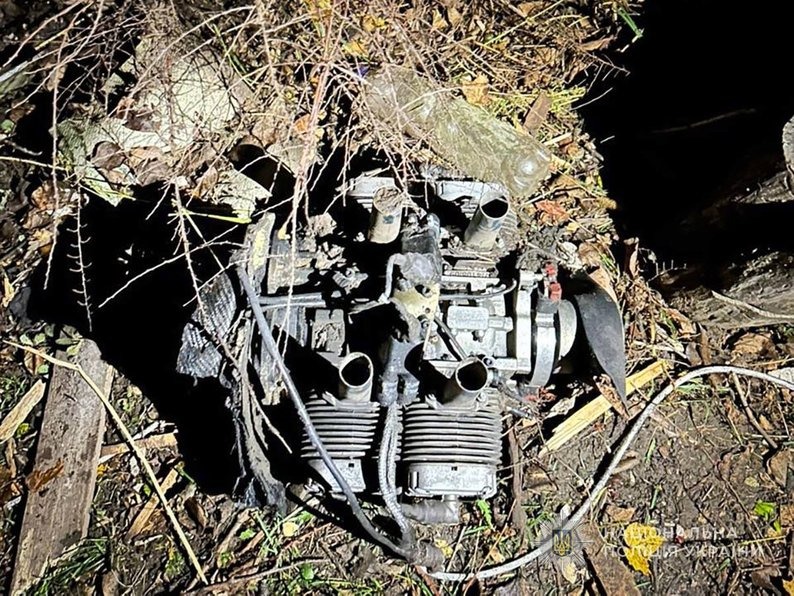
In Kharkiv Oblast, two women were injured when Russian drones hit the village of Prykolotne in Kupiansk District. At least ten detached homes and other structures were damaged, the oblast prosecutor’s office said.
In Kherson Oblast, a 26-year-old man died after a Russian short-range drone dropped explosives on a residential street in Stanislav on 9 November around 4:00 p.m., according to the oblast prosecutor’s office. Law enforcement launched a war crimes investigation.
Elsewhere in Kherson, Russian shelling injured a 49-year-old employee of a scientific institution in the Korabelnyi District. She sustained leg wounds, a concussion, and cranial trauma. In a separate attack, a 59-year-old woman suffered a concussion and head injuries in her own home. Both were hospitalized, the regional authorities said.
In Donetsk Oblast, two civilians were injured in Russian attacks over the past day, said oblast head Vadym Filashkin. Late on 9 November, Russian forces used a Granat-4 drone to strike Sloviansk on 9 November, damaging a two-story apartment building and a vehicle. No injuries were reported in that particular strike.
In Odesa, a drone strike early on 10 November ignited the facade of a four-story residential building. Firefighters quickly extinguished the flames, said Odesa Oblast head Oleh Kiper. There were no injuries or deaths.

Russian strikes on Dnipropetrovsk Oblast sparked multiple fires. In Nikopol and the Pokrovska community, artillery and drones ignited a private home. In the Vasylkivska community of Synelnykove District, a drone strike caused a fire in a church and damaged a bank building, according to acting oblast head Vladyslav Haivanenko. No injuries were reported.
Khmelnytskyi Oblast also came under attack during an air raid on 10 November, but local authorities said there were no casualties or damage.
Zaporizhzhia Oblast authorities recorded 367 Russian strikes in the past 24 hours, according to oblast head Ivan Fedorov. 13 localities came under fire. Russian forces launched seven airstrikes, used 162 FPV drones, 4 MLRS barrages, and 194 artillery strikes.
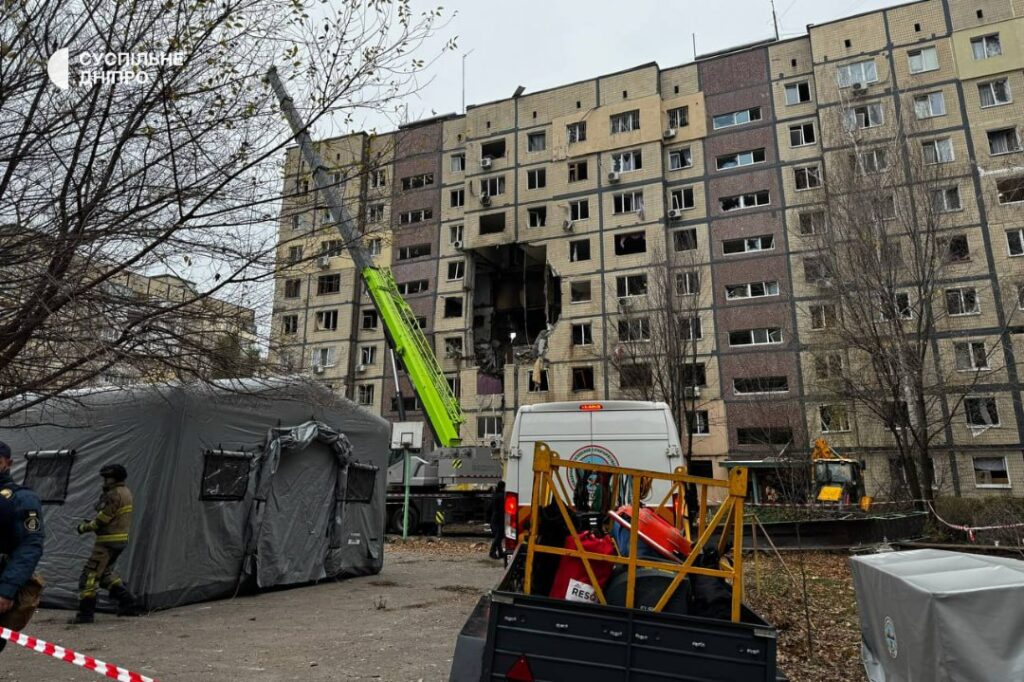

On 9-10 November, have been declared the days of mourning for the victims of a Russian attack on Dnipro, says Mayor Borys Filatov. The Russian night attack killed three people and injured 12 others, including two children, after a Russian drone slammed into a nine-storey building, triggering mass destruction and fire.
The strike on residential buildings constitutes a violation of international humanitarian law, such as Geneva Conventions and Hague Conventions.
Residents are bringing flowers to the site of the strike in memory of the Russian strike victims.

The attack began with the launch of drones, including the one that caused the destruction of floors in the residential building. This was followed by a ballistic strike that caused blackouts across the city. People caught under it prayed in fear, counting at least ten explosions.
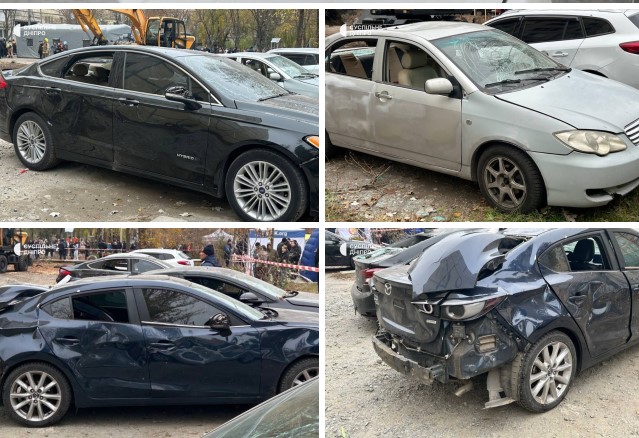
After the strike on the building, Mayor Filatov stated that one and a half sections will need to be demolished, requiring the relocation of 72 apartments in the drone-damaged building. Two building sections remain off-limits due to the risk of structural collapse.
Ukrainian rescuers carried a girl out of damaged building in Dnipro after Russian drone crashed directly into it
— Euromaidan Press (@EuromaidanPress) November 8, 2025
Three people were killed, while others were thrown from their beds and pinned under window frames by blast wave. Russia ruined 111 apartmentsSuspilne Dnipro pic.twitter.com/RjAZfAi8Se
Evhen was waiting for rescuers to find his brother under the debris, when Suspilne journalists asked him for a comment on the strike. Emergency employees already recovered a body of his sister-in-law from the rubble.
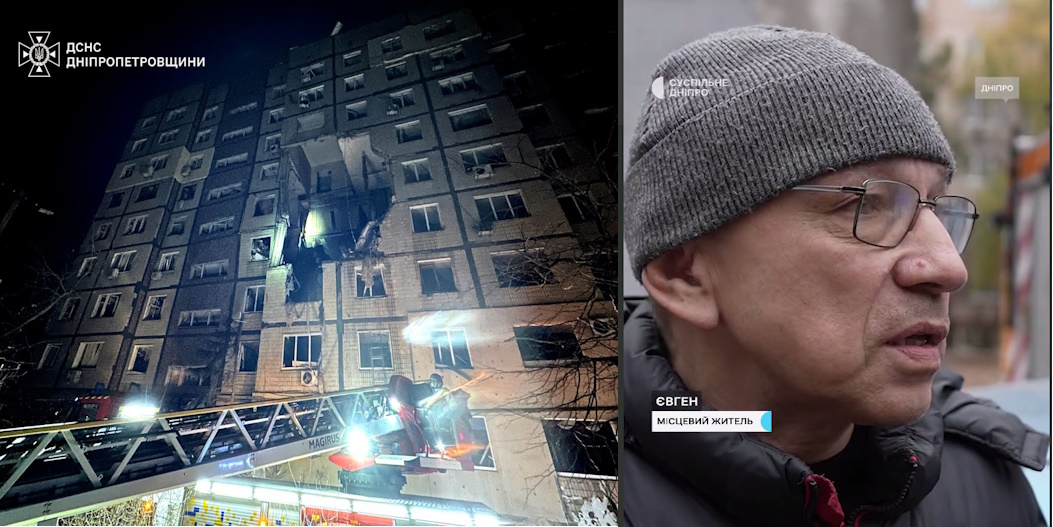
“Their neighbors called me. The rescuers couldn’t give any information — we’re just searching. I will hope until the very end, until I see the body. There is always hope," he said.
In a neighboring section, Olena lives on the sixth floor above her parents. Her mother was pinned to a bed by a window frame during the explosion.

“My mother is fine, but their apartment is uninhabitable — no heating, broken windows. I don’t know how they will live there. My apartment is okay, but it’s scary, of course," she revealed.
Serhii, a soldier from another part of the city, came to the destruction site to help the family of his comrade Volodymyr, who lived on the fifth floor.

“We evacuated him, his wife, and child. They only took their documents. Their apartment is partially damaged, and we can’t access it yet. We’re helping them recover belongings and change clothes," he said.
Inna shared that her 20-year-old daughter and her daughter’s boyfriend were injured and trapped under debris on the third floor. Both are currently in intensive care.

“My daughter has leg injuries and shock, and the boy has a broken arm. I was at work when a friend called to tell me about the strike. Nothing is left of the apartment. I have no words…”
The police reported that 121 people filed claims regarding property damage from the Dnipro attack, with 111 apartments confirmed damaged. At least 1,200 residents may face winter without heating, underscoring the humanitarian consequences of Russia’s attack.
Meanwhile, Ukrainian services are continuing doing all they can to eliminate the consequences of the Russian strike.
On 8 November, Ukrainian President Volodymyr Zelenskyy said the attacks must trigger a unified global sanctions response.
He emphasized that the world must act on frozen Russian assets and increase support for Ukraine to prevent the Kremlin from destroying the country’s civilian energy system before winter.
Experts warn that this winter could be one of the toughest in Ukraine’s history. The world’s response will determine whether the aggressor can be contained or whether the global community allows the destruction of sovereign nations by force.
On 9-10 November, have been declared the days of mourning for the victims of a Russian attack on Dnipro, says Mayor Borys Filatov. The Russian night attack killed three people and injured 12 others, including two children, after a Russian drone slammed into a nine-storey building, triggering mass destruction and fire.
The strike on residential buildings constitutes a violation of international humanitarian law, such as Geneva Conventions and Hague Conventions.
Residents are bringing flowers to the site of the strike in memory of the Russian strike victims.
The attack began with the launch of drones, including the one that caused the destruction of floors in the residential building. This was followed by a ballistic strike that caused blackouts across the city. People caught under it prayed in fear, counting at least ten explosions.


© Mohamed Jamal/Reuters
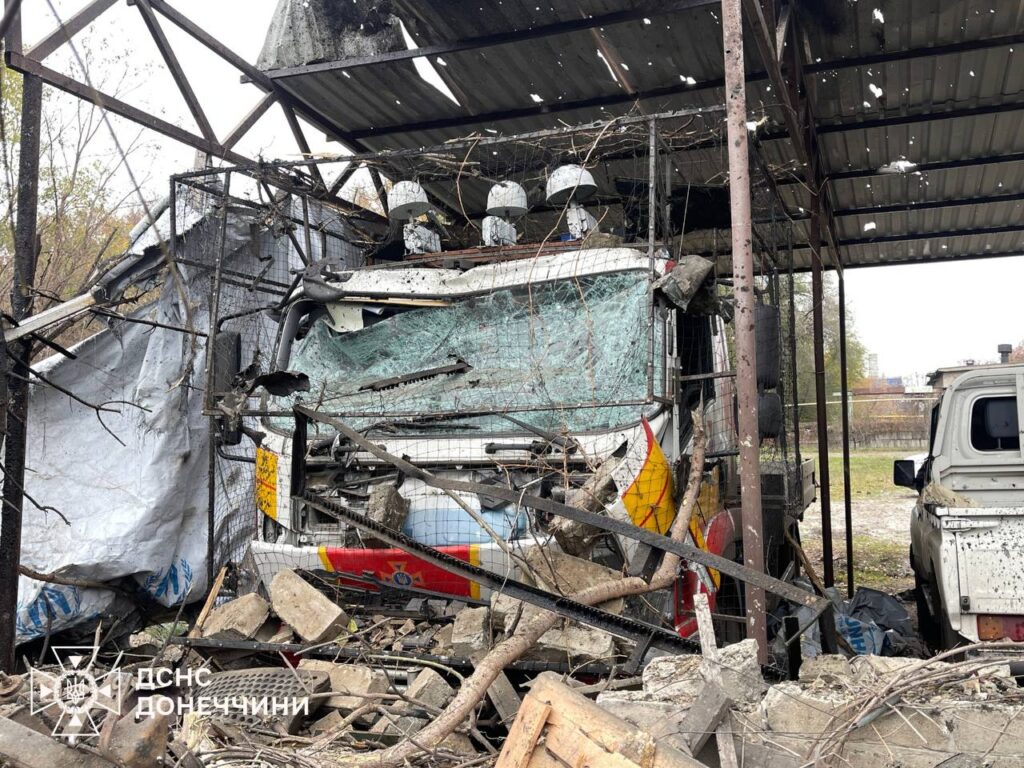

Ukrainian emergency workers have come under direct and repeated Russian fire in recent months, with dozens of attacks resulting in five rescuers killed and over many more injured, Ukraine's Minitry of Interior reported on 5 November. On the day of the reporting, the Russian forces have targeted Ukrainian rescuers in two regions.
Interior Minister of Ukraine Ihor Klymenko wrote on Telegram:
"Over the past three months, Russia has struck State Emergency Service units more than 60 times. As a result of these treacherous attacks, five rescuers were killed and more than 30 wounded."
On 5 November, Russian forces used an FPV drone to deliberately strike a State Emergency Service vehicle in the village of Prymorske, Zaporizhzhia Oblast, Klymenko reported. Four rescuers sustained injuries of varying severity and are receiving medical care.
That same day, a Russian airstrike targeted a fire station in Kramatorsk, Donetsk Oblast. The blast damaged the building, a training tower, and more than ten specialized rescue vehicles. A fire broke out as a result of the strike. No injuries were reported.


© Kenny Holston/The New York Times


Russian forces launched a sweeping overnight assault on Ukraine, striking civilian and energy infrastructure across several oblasts, according to the Ministry of Energy and multiple regional authorities. The air assault left six civilians dead and 13 injured, and plunged the entire Ukraine-controlled part of Donetsk Oblast into a full blackout.
Early on 2 November, authorities reported widespread emergency power outages in the Ukraine-controlled part of Donetsk Oblast. According to the Kramatorsk City Council and the Druzhkivka City Military Administration, Kramatorsk, Druzhkivka, and Sloviansk were among the cities affected.
By 11:30 a.m., the head of Donetsk Oblast, Vadym Filashkin, confirmed the entire oblast under Ukrainian control had been cut off from the national grid due to Russian attacks.
“Emergency power outages began in the national power grid due to enemy strikes on infrastructure,” Filashkin wrote. He added that repair teams had started working to restore power as soon as security conditions allowed.
The Ministry of Energy of Ukraine confirmed the blackout in Donetsk Oblast and partial outages in three more regions, stating:
“Today, Russia again struck energy facilities. Donetsk is completely de-energized, and consumers in Zaporizhzhia, Kharkiv, and Chernihiv are partially disconnected.”
In the early hours of 2 November, Russian drones struck a truck parking lot in Odesa Oblast. The State Emergency Service (DSNS) of Odesa reported that the impact caused a fire involving five trucks, one of which was loaded with soybeans. Emergency crews extinguished the blaze.

The Odesa Oblast Prosecutor’s Office later confirmed two people were killed in the attack. Three others were injured, including one man who was hospitalized with thermal burns; his condition was assessed as moderate. The identities of the deceased were not immediately known. Another injured man, aged 42, was also taken to a medical facility, while two others received treatment on site.
On the evening of 1 November, Russian forces shelled Samarskyi District in Dnipropetrovsk Oblast. Acting head of the Dnipropetrovsk Oblast Military Administration, Vladyslav Haivanenko, reported that four civilians were killed, including two children — boys aged 11 and 14. Seven other people were injured in the strike.

Haivanenko reported on 2 November that a 50-year-old woman who had been critically injured in the attack died in hospital overnight. Rescue workers extinguished a fire caused by the shelling and cleared debris from the site.
Russian forces attacked Zaporizhzhia city overnight on 1–2 November using multiple launch rocket systems. According to Zaporizhzhia Oblast head Ivan Fedorov, three civilians were injured, including an 87-year-old woman who suffered fractures.
The city’s Shevchenkivskyi District was damaged. According to the city council, 65 detached houses were hit. The State Environmental Inspection reported that over 700 square meters were littered with debris, and a crater approximately 30 square meters in size was recorded at the site of impact.
Two Shahed attack drones hit the town of Novhorod-Siverskyi in Chernihiv Oblast overnight on 2 November. According to the head of the Novhorod-Siverskyi District Administration, Oleksandr Seliverstov, the drones struck a residential area. Several civilian homes were damaged, though no casualties were reported.
Ukraine’s Air Force reported that Russia launched a combined attack starting at 7:00 p.m. on 1 November, using 79 attack drones — including Shahed and Gerbera models — and two Iskander-M ballistic missiles. Launch sites included Russia’s Bryansk, Kursk, Oryol, Millerovo, and Primorsko-Akhtarsk.


Ukraine’s Defense Forces carried out a unique airborne operation — a successful parachute-free airdrop in the Pokrovsk area, according to the 7th Corps of the Air Assault Forces.
The maneuver became one of the most daring episodes of the war: coordinated actions by paratroopers, air defense, electronic warfare, reconnaissance, and drone units enabled a breakthrough through Russian lines and strengthened Ukrainian positions.
“It was a complex operation requiring synchronized actions across various branches of the Defense Forces. Under direct Russian threat, we had to ensure safe flight conditions and the successful landing of the personnel,” the 7th Corps reported.
Ukrainian units provided air cover and electronic suppression of the Russian military to secure the mission’s success. As a result, Ukrainian forces improved their tactical positions across several districts of Pokrovsk.
Russia focuses on Pokrovsk because controlling this city would undermine Ukraine’s logistics, weaken its industrial base, and open a path for further Russian territorial gains in the east of Ukraine.
Fighting in Pokrovsk remains intense and dynamic. Ukrainian assault groups are increasing their pace, using diversified movement tactics and disrupting Russian logistics.
“We are keeping the Russians under fire control, and the number of eliminated Russian troops in Pokrovsk continues to grow. Over the past week alone, 85 Russians have been neutralized,” the report said.
According to the 7th Corps of the Air Assault Forces, in October alone, 1,320 Russian troops were killed and another 646 incapacitated within their area of responsibility.
This operation once again demonstrates that Ukrainian paratroopers can operate precisely, rapidly, and fearlessly — even under the most challenging frontline conditions.
Follow Euromaidan Press on Google News! YOUR SUPPORT = OUR VOICE

© NRC, via Associated Press


Ukraine’s Unmanned Systems Forces (SBS) announced on 31 October 2025 that they are opening 15,000 new positions, half of which are available for specialists from civilian life.
Major Robert “Madyar” Brovdi, SBS commander of Ukraine, said the drone units currently make up just 2% of the military but account for 35% of verified strikes against Russian targets. He described the force as a “system that works” and announced its expansion. Brovdi declared that drones are now “waiting for pilots, not the other way around,” urging Ukrainians to join one of the twelve SBS units.
He announced over 15,000 vacancies, emphasizing that many are suited for people with skills from civilian life, such as electronics, programming, construction, or project management. “It is time to scale the system,” Brovdi said in his recruitment video, highlighting that the goal is to increase the SBS share within the Defense Forces from 2% to 5%.
According to Army Inform, the SBS is credited with causing roughly one-third of all verified Russian losses. Brovdi stated that the force has “buried every third Russian worm” and vowed that soon it would be “every second.”


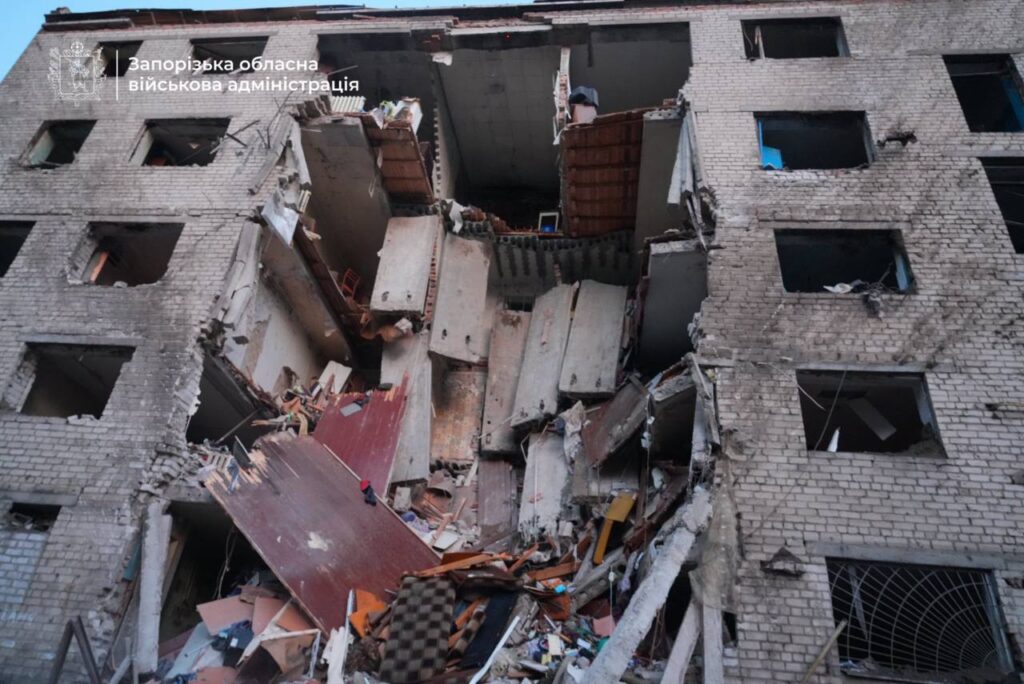

Last night, Russia launched a massive overnight drone and missile barrage that targeted Ukraine’s power grid and civilian infrastructure. While air defenses prevented a majority of the threats from reaching their targets, the attack caused damage — with fatalities, blackouts, and destroyed infrastructure in several regions. The attack killed at least two people, injured nearly 20 — including children.
Ukrainian President Volodymyr Zelenskyy condemned the assault as a continuation of Russia’s "terror" war against civilian life and called for new sanctions against Russia.
The combined Russian attack began late on 29 October and continued into the morning of 30 October. Ukrainian monitoring channels tracked waves of Shahed explosive drones entering airspace starting at 17:04, with the first explosions reported in Chernihiv. Hours later, missiles were launched from various platforms, including air-, sea-, and land-based systems. Russian forces employed ballistic, cruise, and aeroballistic missiles, including Kinzhal and Kalibr types.
Air alerts were active across most of Ukraine overnight, and explosions were heard in multiple oblasts, including Zaporizhzhia, Dnipropetrovsk, Lviv, Khmelnytskyi, Ivano-Frankivsk, and Kyiv. The Zaporizhzhia attack lasted several hours, with drones preceding ballistic strikes.
Ukraine’s Air Force reported that from 19:00 on 29 October, Russia launched a complex combined aerial attack involving 705 total air threats: 653 drones and 52 missiles of various types.
Intercepted or suppressed aerial threats included:
President Zelenskyy addressed the attack in a statement, confirming hits on residential areas in Zaporizhzhia, where dozens were injured and two people killed. The Russian attack critically injured a seven-year-old boy in Ladiyzhyn, Vinnytsia Oblast, the President reported.
“Russia continues its terrorist war against life,” Zelenskyy said, calling for increased pressure on Moscow, including sanctions targeting oil, gas, and finance sectors, and secondary sanctions against those who sponsor the war.
He added that Ukraine expects the United States, Europe, and G7 countries not to ignore Moscow’s intent to destroy everything.
Zaporizhzhia was among the most severely hit oblasts. Russian forces struck the city with both missiles and drones over several hours overnight, hitting five apartment buildings and several one-family homes, according to local authorities.
One Russian missile hit a dormitory, destroying multiple floors. Rescue teams recovered the body of a 62-year-old man identified by his sister.

"A woman recognized her brother’s house in a news report and began trying to reach him by phone. She later rushed to the scene, where, during the recovery of the body, she identified her brother," Suspilne wrote.
Later, the rescuers pulled another victim from the rubble.
According to the Zaporizhzhia Oblast Prosecutor’s Office, five apartment buildings and several private houses were damaged. In total, 17 people were injured, including six children.
Infrastructure facilities were also hit, and fires broke out in residential areas. A criminal investigation for war crimes has been launched.
Kyiv Oblast came under a mass drone attack, with air defenses shooting down around 60 Shahed drones, the oblast administration reported. No damage to critical infrastructure was reported, but a 35-year-old woman in Boryspil was hospitalized with severe injuries.

In Cherkasy Oblast, drones and missiles targeted Zvenyhorod area, the oblast authorities said. Drone debris damaged a power line and several civilian homes, and caused a fire at a farm building. One animal was killed in the blaze. Authorities confirmed no civilian injuries.
According to regional officials, Ukrainian air defenses destroyed 12 drones and one missile over the oblast.

Explosions were reported in Dnipro and surrounding areas. The local power grid suffered significant disruptions, forcing Ukrainian Railways to switch to backup locomotives. At least 11 passenger trains were delayed due to the outage, according to Suspilne.
Russian air attacks targeted infrastructure in Rivne Oblast. Local officials said civilian facilities sustained minor damage. There were no injuries.
Ukrainian Air Force monitoring channels reported possible launches of Kinzhal missiles toward Rivne, and drone activity was recorded in the southern parts of the oblast.
Lviv Oblast suffered hits to two energy infrastructure sites as part of the overnight attack. The regional military administration confirmed power outages and introduced hourly shutdown schedules. Several private buildings and a vehicle in the town of Khodoriv were also damaged.
Authorities said repairs were underway and heating season preparation was not interrupted due to backup systems.
In Chernivtsi Oblast, three Russian cruise missiles were detected in the airspace. One was shot down, and its debris damaged a power line in Novoselytsia community. No injuries were reported.
A strike on an energy facility in Odesa Oblast injured one energy worker, who received medical treatment. Damage was described as “significant” by DTEK energy company. About 26,900 households temporarily lost power, while critical infrastructure was restored using backup generators.
The oblast administration reported that air defenses shot down 22 Russian drones over Dnipropetrovsk Oblast.
A Russian missile targeted an enterprise in Dnipro. Drone strikes hit Synelnykove district, causing fires and damaging infrastructure and private houses. In Nikopol district, Russian forces used FPV drones and artillery against several communities.
The authorities reported no casualties in the region.
Russian forces continued shelling and bombing Sumy, Kharkiv, and Donetsk oblasts, according to local authorities.


© Airbus Ds 2025/Airbus DS 2025, via Associated Press


Russia launched a terror strike with 126 drones across Ukraine overnight on 29 October, targeting energy infrastructure and leaving nearly 30,000 civilians without power as temperatures drop. Energy workers are conducting emergency restoration operations.
Ukrainian forces shot down or electronically suppressed 93 drones out of 126, while 32 struck targets across 10 locations, according to the Air Force.
The most severe damage occurred in southern Odesa Oblast, where Russian forces struck a DTEK energy facility.
The State Emergency Service of Ukraine reported that fires that broke out required 21 rescuers and six emergency vehicles to extinguish.
Oleh Kiper, head of Odesa Oblast Military Administration, confirmed that both energy and transport infrastructure were damaged in the attack.


One energy worker was injured in the strike and received medical assistance.
According to DTEK energy company, 26,900 consumers remain without electricity in Odesa Oblast following the attack, though energy workers have reconnected approximately 7,000 families by switching to backup power lines where technically possible. Critical infrastructure facilities are currently operating on generators while restoration work continues.
In frontline Kharkiv Oblast, Russian drone strikes hit the cities of Izium and Chuhuiv, causing fires at civilian facilities, according to the State Emergency Service.
In Izium, drones struck an educational institution, an unfinished office building, and a destroyed shopping center, injuring one woman.


In Chuhuiv, a production building at a civilian enterprise caught fire over 1,000 square meters, though no casualties were reported there.
In northeastern Chernihiv Oblast, an Iranian-designed Shahed drone struck a critical infrastructure facility in the city center. Authorities are still clarifying information about potential casualties.


Russia launched an unusually small drone attack overnight on 27–28 October, using just 38 UAVs instead of a hundred or the hundreds typically deployed each night. But despite the reduced numbers, the explosive drones still caused damage across Ukraine. Moreover, other Russian attacks over the past 24 hours killed three civilians and injured at least 13 more with FPV drones, artillery, and air-dropped munitions, local authorities say.
According to Ukraine’s Air Force, Russia launched 38 long-range UAVs—mostly explosive Shaheds, along with decoy Gerbera and other types—from the directions of Kursk and Oryol. About 25 were Shaheds.
Ukraine’s defenders used aviation, missile units, electronic warfare, drone systems, and mobile fire groups. By 9:00, 26 drones were downed or suppressed over the north and east. Twelve reached targets at four locations, and debris fell on a fifth. Several drones remained airborne into the morning.
A Shahed exploded in central Chernihiv at 23:50, knocking out mobile communication, according to Suspilne. The Air Force had earlier reported drones approaching from the east.
Earlier that day, four homes were damaged by a Russian drone; one man was hospitalized with shrapnel injuries.
Later that night, another Russian drone hit a retreat center in Novhorod-Siverskyi, injuring an elderly woman and sparking a fire.
Eight FPV drones struck the Ochakiv and Halytsynivka communities, while artillery hit Kutsurub. In Dmytrivka, a school, kindergarten, private home, and power line were damaged. Power was restored by morning, the regional authorities said.
Russian artillery and drones struck Nikopol and Pokrovska, setting a house and utility structure on fire. A farm and gas pipeline were damaged. In Shakhtarska, a drone damaged infrastructure. The oblast authorities reported no casualties.
Russian troops shelled 25 settlements in Kherson Oblast throughout the day using multiple types of weaponry. The Russian attacks damaged a multi-story building, six detached houses, garages, outbuildings, and civilian vehicles. One person was killed and six others injured, according to oblast head Oleksandr Prokudin.
The local authorities say Russian forces hit 15 settlements with 396 strikes. Four airstrikes targeted Ternuvate, Novyi Zaporizhzhia, Novouspenivske, and Malynivka. The Russians shelled Prymorske, killing one civilian. An airstrike on Ternove injured one and damaged a school and homes. FPV drones and artillery struck multiple other locations, injuring two more.
On 27 October, the number of confirmed civilian casualties in Donetsk Oblast rose by one killed and one injured, regional head Vadym Filashkin reported. The tally does not include areas such as Mariupol and Volnovakha.
Kharkiv Oblast authorities reported that Russian strikes hit three settlements using 1 "Geran-2"—it's the Russian designation for the Iranian-designed Shahed-136—and 1 FPV drones. A 41-year-old man was injured in Kupiansk on 26 October and received medical care.
The Russians reportedly hit Sumy Oblast with 10 KAB guided bombs over the past 24 hours and targeted the region with FPV drones.


© Brendan Hoffman for The New York Times


Russia’s claims of victory in Ukraine are pure fiction, argues retired US General Jack Keane in his 24 October 2025 New York Post opinion piece. Despite nearly four years of all-out war, Russia is bleeding manpower, facing a collapsing economy, and relying on lies to mask its military failure.
Keane, chair of the Institute for the Study of War, says Kremlin propaganda conceals the reality that Russia is losing militarily and internally.
According to Keane, Vladimir Putin insists that victory in Ukraine is inevitable and refuses any peace deal that does not hand him full control of the Donbas. Yet after years of fighting, Russia’s forces remain stuck in place. They have failed to take any major Ukrainian city since 2022 and now fight for small towns and empty fields at what Keane calls “extravagant losses.”
Ukraine’s resistance, aided by effective drone warfare, has forced Russian troops to abandon tanks and mechanized formations. Instead, they attack in small squads of three to five soldiers, suffering massive casualties to move only meters forward. Keane cites data showing that in 2025, Russian forces lost an average of 70 to 75 soldiers for every square kilometer captured — a rate he calls “horrifying.”
Keane writes that without China, North Korea, and Iran, Russia’s war effort would collapse. He highlights that 10,000 North Korean troops helped Moscow retake Kursk — a move he calls embarrassing.
Even as Russia loses 35,000 troops per month, the Kremlin is cutting enlistment bonuses. Keane suggests forced mobilization may follow, risking backlash at home.
Keane reports Russia’s sovereign wealth fund dropped from $113 billion in 2022 to $50.26 billion by October 2025. The country faces 16.5% interest rates and a 13–20% gasoline shortage due to Ukrainian refinery strikes. Trump’s sanctions have also hurt oil revenues.
Despite this, the Kremlin raised propaganda spending by 54% in its 2026 budget, flooding media with false victories to hide battlefield losses and economic pain.


© Agence France-Presse — Getty Images


Russia launched strikes across Ukraine overnight on 25 October, including a double-tap attack in Dnipropetrovsk Oblast that killed a rescue worker responding to the initial strike - a tactic that violates Geneva Conventions protections for emergency responders.
The assault also damaged a kindergarten in Kyiv and killed at four people in total, with ballistic missiles and drones hitting residential areas.
The Russians launched nine Iskander-M ballistic missiles, along with 62 drones, approximately 40 of which were Iranian-deisgned Shaheds, according to the Air Force Command of the Armed Forces of Ukraine.
Air defense systems shot down or suppressed four ballistic missiles and 50 drones across the north, south, and east of the country by 09:00 a.m. However, five ballistic missiles and 12 strike drones hit 11 locations, with debris falling at four additional sites.


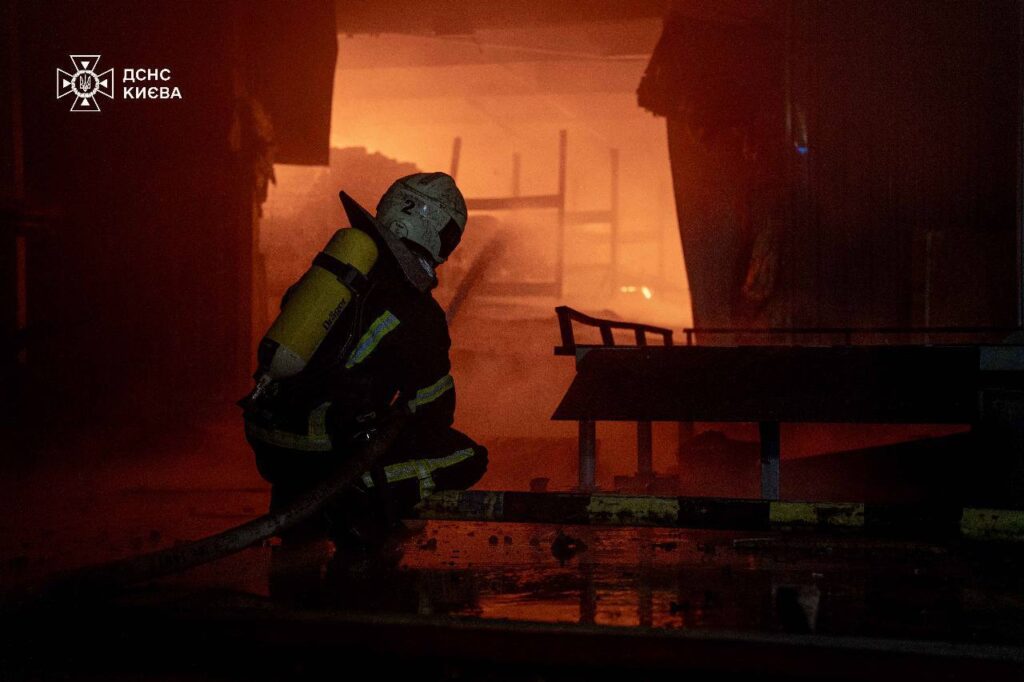
The capital sustained a ballistic missile attack that killed two people and wounded 10 residents, according to Kyiv City Military Administration head Tymur Tkachenko.
The strikes hit Desnyanskyi, Dniprovskyi, and Darnytskyi districts, with a kindergarten in Dniprovskyi district among the damaged structures.
A Russian ballistic missile tore a crater between apartment buildings in Kyiv during an overnight attack on 25 October.
— Euromaidan Press (@EuromaidanPress) October 25, 2025
The aftermath of the Russian strike on Kyiv:1 person killed
10 people wounded
3 people hospitalized
kindergarten damaged
shattered windows and… pic.twitter.com/oEN0SdCXq8
Missile debris fell on open ground in some areas, damaging window glass in buildings, while a non-residential building caught fire at another location, according to the State Emergency Service.
A crater formed between apartment buildings in Darnytskyi district. Three of the wounded were hospitalized to city medical facilities.

Two people died in Dnipropetrovsk Oblast, including Master Sergeant Oleksandr Yehorychev, a driver of the 37th State Fire and Rescue Unit, according to the State Emergency Service.
Yehorychev was killed during a repeated Russian missile strike on Petropavlivska community in Synelnykivskyi district on the evening of 24 October. He was extinguishing a fire caused by a Russian drone strike when he came under the repeated missile fire and received severe injuries.

Another rescuer was wounded in the same strike. A woman also died, and seven people sustained injuries.
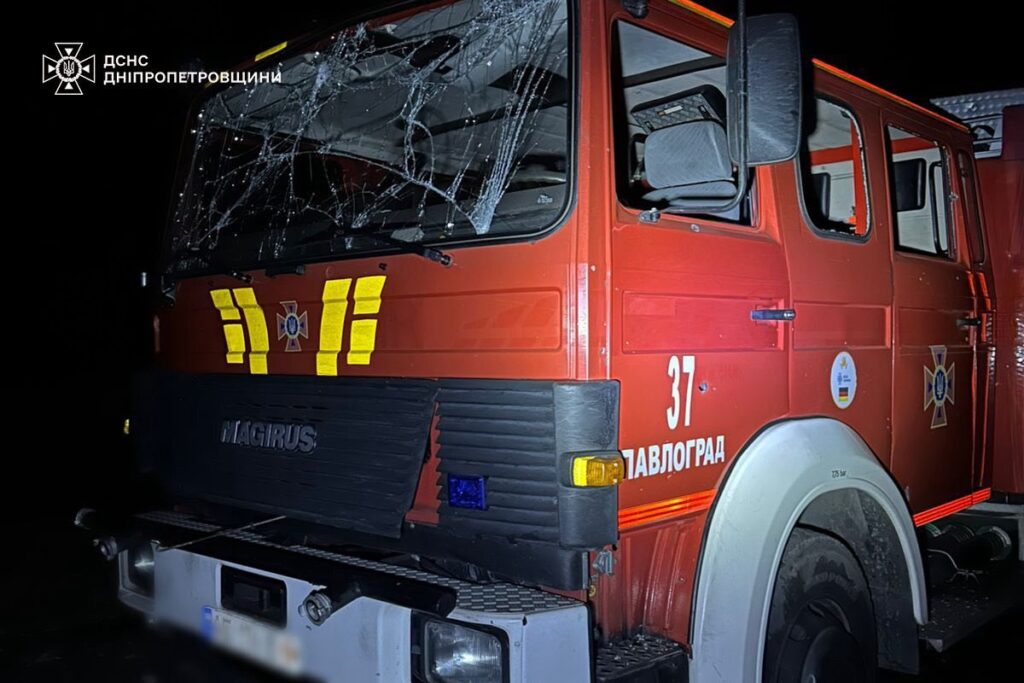

The attacks damaged two fire and rescue vehicles, residential buildings, and shops.
Kamikaze drones also struck Pokrovsk community in the region, destroying a residential building and sparking a fire.




Ukrainian Special Operations Forces (SSO) reported an infiltration into Russian-held territory in Donetsk Oblast, where they carried out a deadly strike behind enemy lines. According to the report, the 8th SSO regiment eliminated three Russian soldiers, captured critical matériel, and supported nearby Ukrainian units preparing to retake lost positions.
According to the Special Operations Forces, the operators of the 8th separate SSO regiment carried out a successful raid on one of the sectors in Donetsk Oblast. The mission began as a reconnaissance operation behind enemy lines, with the group ordered to cross the frontline undetected, assess Russian positions, and be ready for direct action, Militarnyi notes.
Their task was critical for the success of neighboring Ukrainian formations that were preparing to restore control over previously lost positions.
The Command of the Special Operations Forces of the Armed Forces of Ukraine published video footage of the mission on 23 October. The video confirms the successful completion of the operation and the seizure of Russian equipment.
The Ukrainian SOF unit approached from behind, avoided detection, and initiated a swift assault on a Russian group. As a result, three Russian servicemen were killed on the spot. Ukrainian forces also captured Russian communications gear, navigation equipment, and documents during the raid.
The SSO says its group "completed the mission and created favorable conditions for the implementation of the overall plan on this section of the front."


© William L. Rukeyser/Getty Images
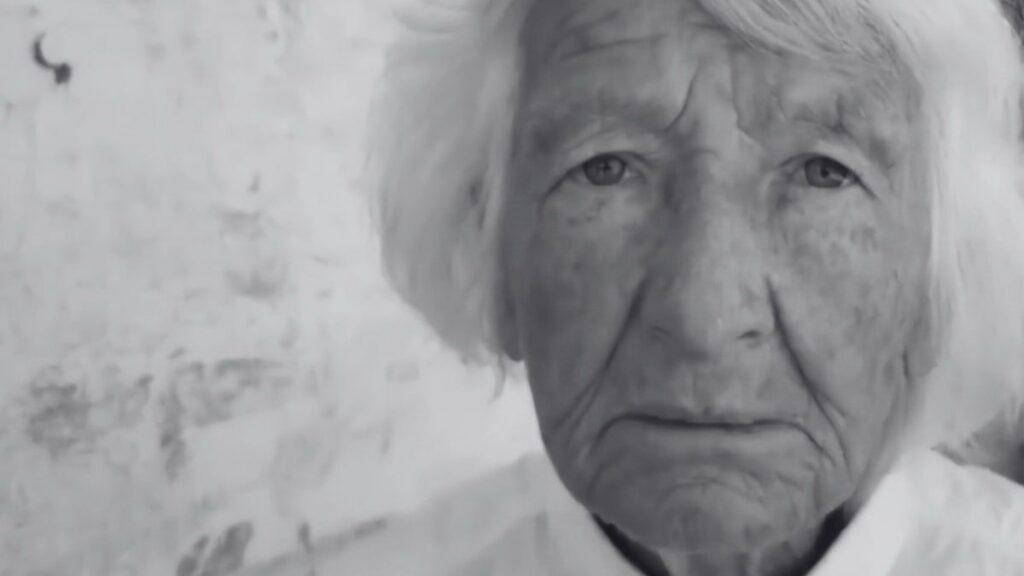

An 84-year-old woman was killed by a Russian drone in Kherson Oblast on 20 October while tending to her goats—just weeks after explaining to an American journalist why she refused to evacuate despite daily attacks on civilians.
Such drone attacks occur each day in Ukrainian regions within the range of the small FPV drones, with Russians intentionally targeting civilians. This September, the UN confirmed that this Russian systematic civilian killing campaign amounts to a crime against humanity.
Larysa Vakuliuk, known locally as Baba Lora or Grandma Lora, was walking with two goats in the Antonivka neighborhood of Kherson when a Russian FPV drone struck them. She died instantly. Both goats were also killed.
"Her legs were blown off, she was blown to pieces," said Zarina Zabrisky, the American journalist who interviewed Vakuliuk in September.
Kherson's Main Directorate of the National Police confirmed the death on 21 October.
"She was a tiny little lady that showed up near Antonivka, such a curious figure, dressed in a white, almost starched shirt, with bright eyes and a whimsical smile," Zabrisky, who is now in Kherson, told Euromaidan Press. She found out about the death of Lora from the local Telegram channel.
"I've seen a lot of deaths in my three-and-a-half years of reporting on the war, but this one really got to me. I was so angry, I was banging my fists off the wall."
The most cynical part is that the Russians see the civilians and deliberately target them, Zabrisky said: "They kill them while seeing them. They see that it's a little old lady."
Sadism is part of it, but the civilians and animals also become training targets for the Russians. Military sources told Zabrisky that the Russians have a pilot school in Rostov-on-Don, the graduates of which are sent to occupied Ukraine near Kherson to practice.
That's why the Russian drone pilots hit goats, dogs—and old ladies.
However, the FPV drones are only one small part of the deadly arsenal with which Russia strikes Kherson: Zabrisky says that they hit the city each hour, destroying a block a day with aerial bombs, artillery, mortars, and even Shahed drones—usually reserved for long-range attacks.

In her September interview with Zabrisky, Vakuliuk explained why she stayed in Antonivka despite the constant threat. She had over 20 goats and felt responsible for them. Russian shelling had already destroyed her house, as well as nine apartments nearby.
"I'm ancient. What should I be afraid of? Everyone is afraid. All are scared, but each has hope," Vakulyuk told Zabrisky.
I can’t. The monsters killed her.
— Zarina Zabrisky
I spoke to her a few weeks ago. For f^^* sake. God damn, god damn them, god damn Russians.
Burn in hell https://t.co/yfChLvcGPb(@ZarinaZabrisky) October 20, 2025
She also shared a grim observation, sharing that all the cattle herders who herded cows in the village have already been killed by Russian attacks.
Most people who remain in Kherson live in basements due to the heavy Russian shelling, Larysa Vakuliuk told Zabrisky in September. They have nothing but their chickens, yet they stay, "because it's their own."
"You should help us, from America," Vakuliuk implored.
Vakuliuk's death is part of what the UN Commission of Inquiry on Ukraine has documented as deliberate, systematic attacks on civilians with short-range drones—strikes that constitute crimes against humanity of murder and war crimes of attacking civilians.
In findings released on 22 September 2025, the Commission concluded that Russian forces operating from the left bank of the Dnipro use drones with real-time tracking to pursue individuals, drop explosives directly on them, and attack civilian vehicles.
"The circumstances of the attacks show the perpetrators' intention to kill, harm and destroy," said Erik Møse, chair of the inquiry.
The Commission documented drone assaults across Kherson, Dnipropetrovsk, and Mykolaiv oblasts, spanning more than 300 kilometers of front-line territory. Russian forces killed 133 civilians and injured 1,350 between July and October 2024 alone in what locals call "human safaris."
By spring 2025, Kherson residents reported up to 100 drone attacks daily. Civilian casualties from explosive weapons in Ukraine rose by 40 percent in the first eight months of 2025 compared to the previous year, with drone strikes representing a growing share.
"Drones chase us, we hide from them," one Kherson resident told UN investigators. "Drones sit on rooftops, and if they see something, there will be consequences."
The Commission also reported that ambulances, fire engines, and other emergency responders bearing visible markings were struck, preventing life-saving work in the aftermath of attacks.
Zabrisky has been documenting Russia's systematic targeting of Kherson civilians since July 2024, when she first reported on the "human safari" in international media.
Her documentary film "Kherson: Human Safari," released this year, captures life in Kherson Oblast during Russia's full-scale invasion. The film was shot between September 2023 and June 2025 and is available for free viewing at khersonhumansafari.com.
The documentary features testimony from Kherson residents, including artist Alyona Maliarenko and composer Borys Hoina, alongside footage of drone attacks on civilians.
"When civilization is in decline, and your city is in ruins—what do you do to survive... and remain human?" Zabrisky asks in the film.
Russia has occupied the left bank of the Dnipro River in Kherson Oblast since retreating from the city of Kherson in November 2022. The city remains under constant artillery, missile, and drone attacks from Russian forces across the river.

I can’t. The monsters killed her.
— Zarina Zabrisky
I spoke to her a few weeks ago. For f^^* sake. God damn, god damn them, god damn Russians.
Burn in hell https://t.co/yfChLvcGPb(@ZarinaZabrisky) October 20, 2025


© Greg Kahn for The New York Times


© Sofiia Gatilova/Reuters


President Volodymyr Zelenskyy condemned the attack, emphasizing that there can be no justification for striking a kindergarten with a drone.
Zelenskyy's comments come as Russian forces struck Kharkiv with at least three explosions in the morning, hitting a private kindergarten in the Kholodnohirskyi district.
"A Russian drone strike on a kindergarten in Kharkiv – after a night of massive attacks. Unfortunately, one person is known to have been killed. My condolences to the family," Zelenskyy wrote.
According the city's mayor Ihor Terekhov, six people were injured, including children.
The Russian army attacked with Shahed drones. All children have been evacuated from the kindergarten, while the fire continues, Terekhov said.

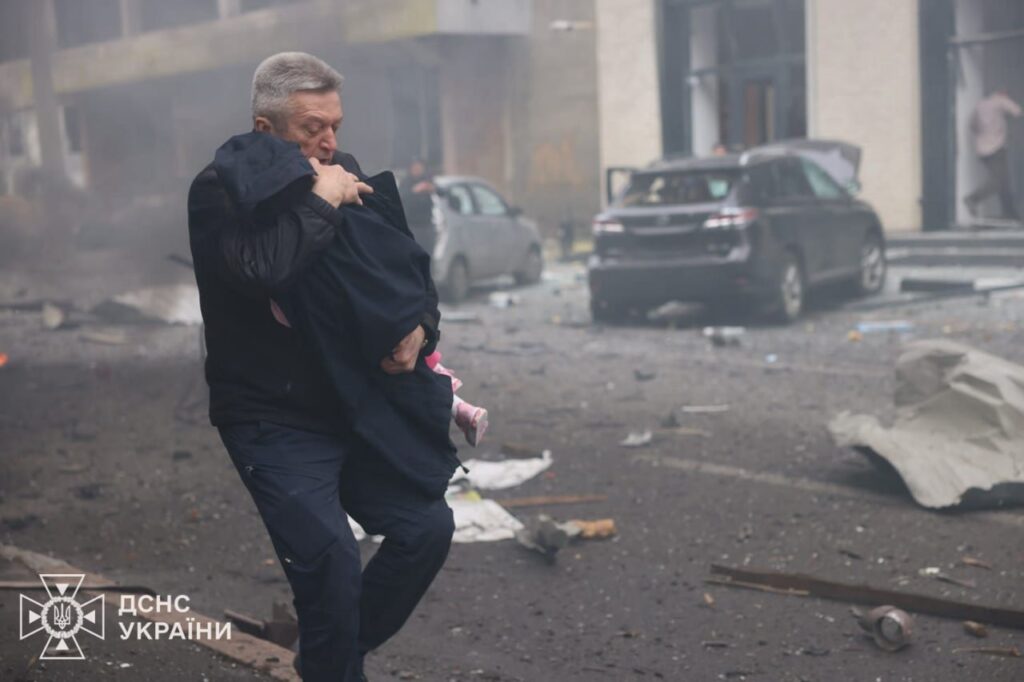



Kharkiv Oblast Governor Oleh Syniehubov reported about four casualties from the attack.
"At least two of them are in critical condition. Medics are working on site," the regional head said.
Terekhov clarified that one of the injured is unconscious in intensive care.
Syniehubov later added information about two more casualties. "A man and a woman, they are being hospitalized. The woman is in critical condition with burns. Medics are providing all necessary assistance," the governor wrote.
At 11:41 am, Terekhov said that the strike on the kindergarten killed one person and injured five more. Syniehubov specified that a 40-year-old man was killed.
"There is and can be no justification for a drone strike on a kindergarten. It is obvious that Russia is becoming more brazen. These strikes are Russia's spit in the face of everyone who insists on a peaceful solution," the president said. "Bandits and terrorists can only be put in place by force."
The morning attack follows the overnight massive drone and missile attack on Kyiv, its oblast and other oblasts. As of 12 pm, four people were killed and 19 injured in the Kyiv Oblast.


President Volodymyr Zelenskyy said on the morning of 22 October that the overnight attack demonstrates that Russia "doesn't feel enough pressure" for prolonging the war.
"All night and morning, our air defense forces, mobile fire groups, and interceptor drone crews worked. Ordinary cities were under attack, mainly our energy infrastructure, but there were many hits on residential buildings," Zelenskyy said.
President Zelenskyy's comments come as four people, including two children, were killed in Kyiv Oblast during Russian strikes overnight and in the morning of 22 October, according to the State Emergency Service and Kyiv Oblast Military Administration head Mykola Kalashnyk.
According to Kyiv city mayor Vitalii Klitchko, two Kyivans killed due to the Russian attack.
Three people were killed in Zazymska hromada, including children, the State Emergency Service reported. The victims in the village of Pohreby, Brovary district, were identified as a young woman born in 1987, a six-month-old baby, and a 12-year-old girl, Kalashnyk said. "Their bodies were found at the site of a fire in a private house," the oblast head specified.
Later, Kalashnyk confirmed that debris in Brovary district fatally injured a man born in 1987.
An 83-year-old woman was also injured in Brovary. Rescuers pulled her from a burning house.
In Brovary, debris caused a fire in a private house and ignited a truck with a trailer. The fires have been extinguished.
According to Kyiv City Militray Administartion head Tymur Tkachenko, 29 people, including five children, were injured due to the night attack.
President Zelenskyy emphasized that Russian diplomatic statements are meaningless until Russian leaders face critical consequences, which can only be achieved through sanctions, long-range capabilities, and coordinated diplomacy from all partners.
"The time has come for the European Union to adopt a strong sanctions package. We also count on strong sanctions steps from the US and the G7, from all who seek peace. It is very important that the world not remain silent right now, and that there be a joint response to Russia's vile strikes," the president added.
In Zaporizhzhia, Russian forces carried out nine kamikaze drone strikes on the city overnight. The number of victims has risen to 15 people, said Oblast Military Administration head Ivan Fedorov. Fires broke out in a multi-story building and several private houses in one district of the city. Five casualties were initially reported.
In Kherson, Russian forces struck the Korabelny district with artillery around 5:00 am, injuring an elderly couple. A 75-year-old woman and a 78-year-old man sustained blast injuries and concussions, according to Oblast Military Administration head Oleksandr Prokudin. Medics provided assistance to them. The shelling damaged a private house and an outbuilding.
Earlier, the Oblast Military Administration reported that Russian forces dropped explosives from a drone on a car in Kherson's Dniprovskyi district around 6:30 am.
Explosions were also heard in Dnipro and Odesa Oblast overnight.
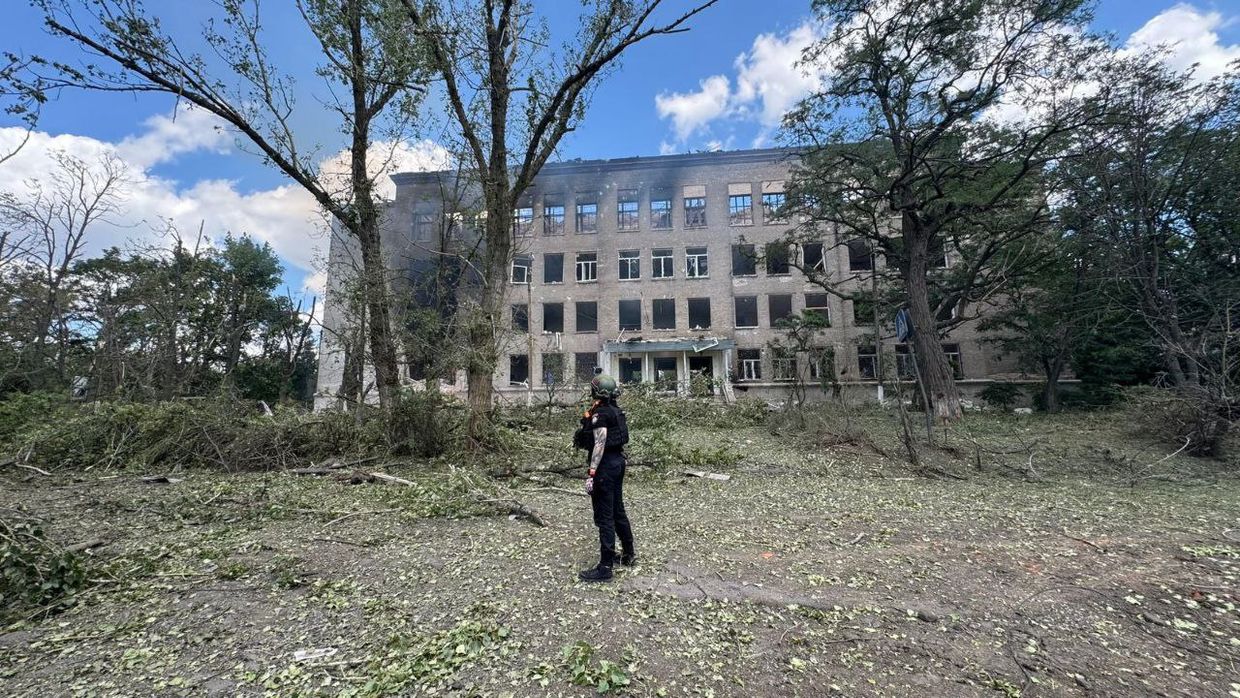

Russian attacks on two towns in Donetsk Oblast left five people dead and another injured on July 6, Governor Vadim Filashkin reported.
Russia attacked the front-line towns of Kostiantynivka and Druzhkivka.
In Kostiantynivka, Russian airstrikes and missile attacks killed four people and injured another person, Filashkin said. The heavy attacks also damaged 14 homes, four high-rise buildings, an administrative building, a car, and five power lines.
In Druzhkivka, a Russian first-person-view (FPV) drone killed one person and damaged equipement.
Filashkin warned that both Kostiantynivka and Druzhkivka are "under constant enemy fire" and urged residents to relocate.
"It is dangerous to stay here! Evacuate to safer regions of Ukraine!" Filashkin wrote on Telegram after the attack.
In late June, Filashkin reported that Kostiantynivka, in eastern Donetsk Oblast, faces an imminent "humanitarian catastrophe." The town lies just 10 to 15 kilometers (6 to 9 miles) from several areas currently occupied by Russian forces, according to battlefield mapping site DeepState.
Kostiantynivka has come under intensified attack in recent months as Moscow pushes westward beyond its gains around other nearby towns.
 The Kyiv IndependentTim Zadorozhnyy
The Kyiv IndependentTim Zadorozhnyy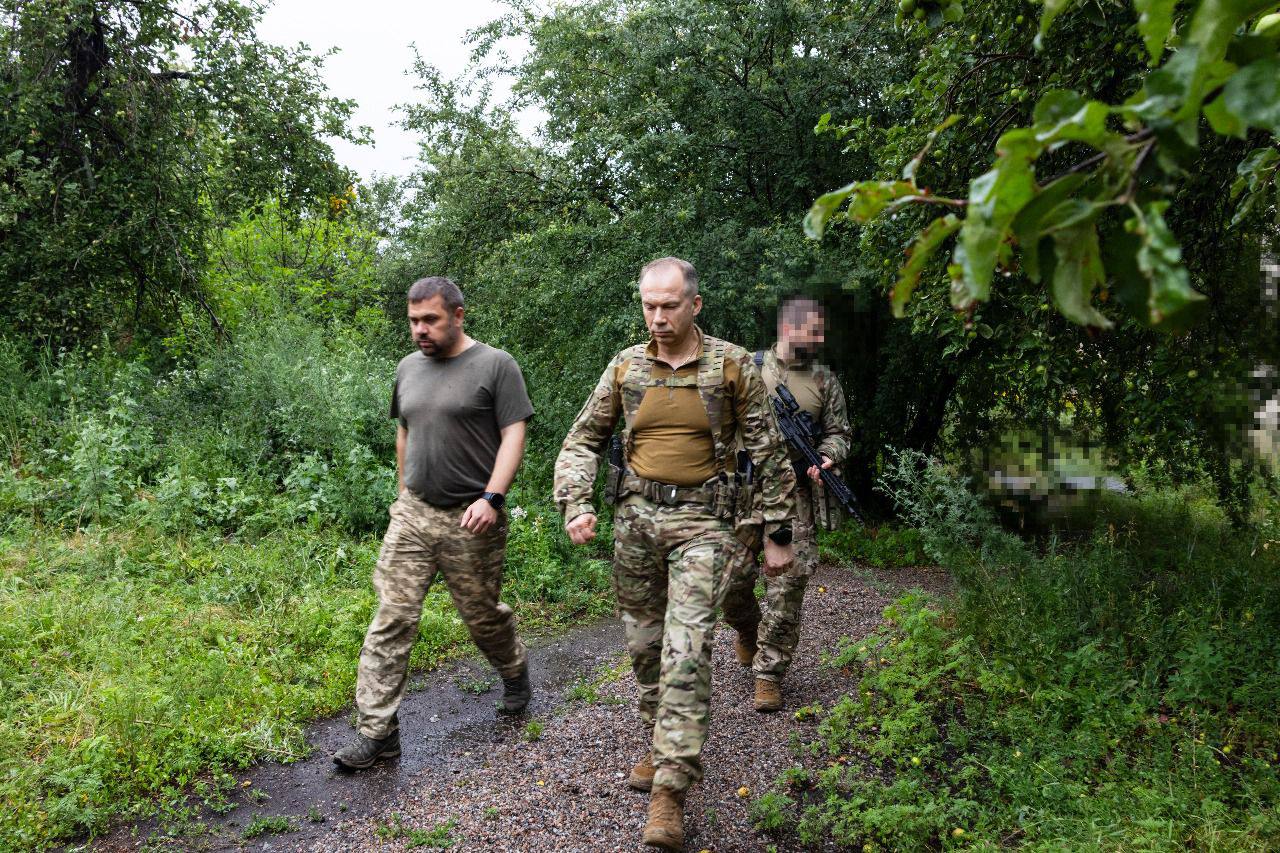
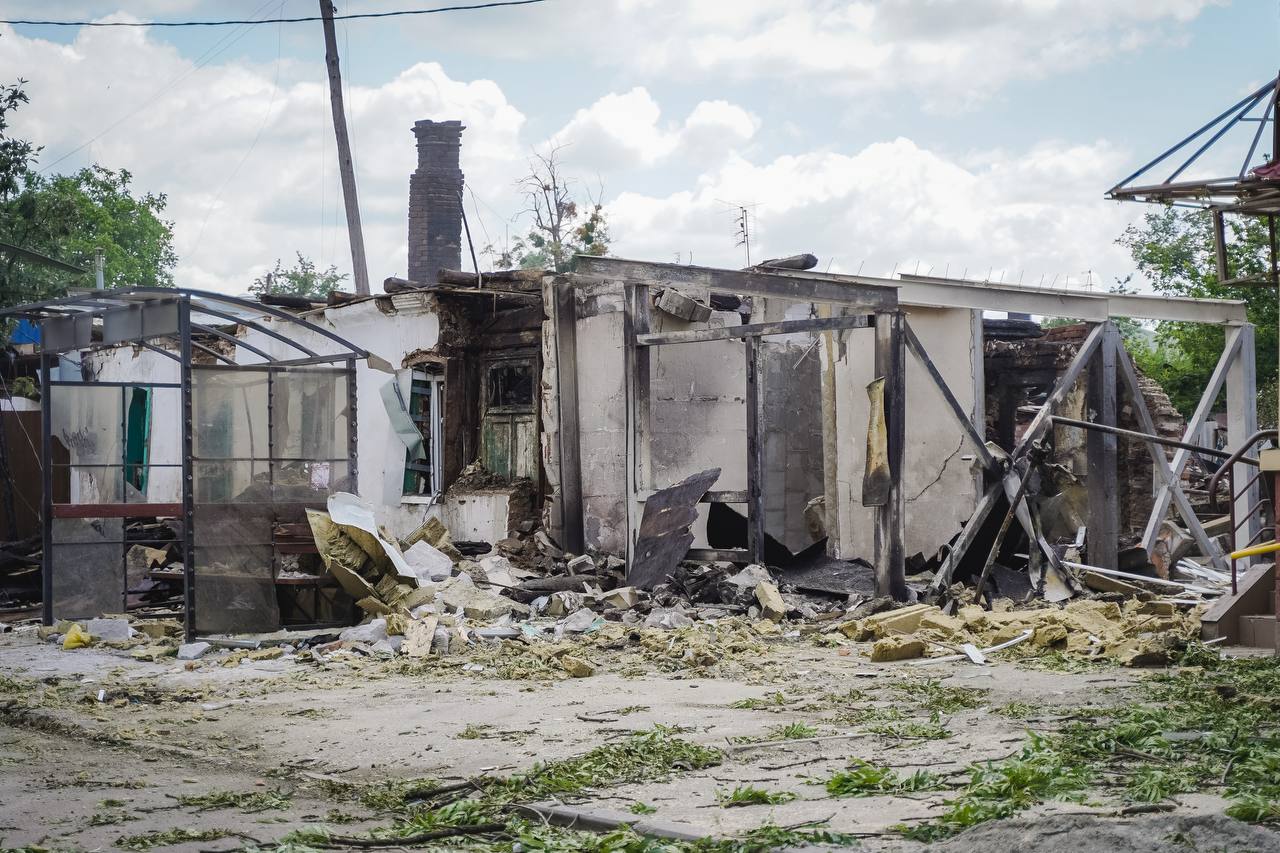

A woman injured in Russia’s July 3 attack on Poltava has died in the hospital, bringing the total number of fatalities to three, the local military administration reported on July 6.
The attack injured 59 people, sparked fires, and damaged civilian infrastructure.
"Doctors fought for her life to the last. Our sincere condolences to her family and friends!" Poltava Oblast Governor Volodymyr Kohut wrote on Telegram.
One of Russia's July 3 strikes caused a fire at the Poltava military enlistment office. A separate strike nearby set fire to a private residential property, the authorities said.
Vitalii Sarantsev, a spokesperson for Ukraine's Ground Forces, said on national television that the attack on the enlistment office in Poltava was deliberate and that such strikes are intended to disrupt mobilization in Ukraine.
This wasn't the first time Russia has been linked to such attacks. Back in February, Moscow recruited the man who carried out a deadly bombing at a military enlistment office in the city of Rivne in northwestern Ukraine.
 The Kyiv IndependentChris York
The Kyiv IndependentChris York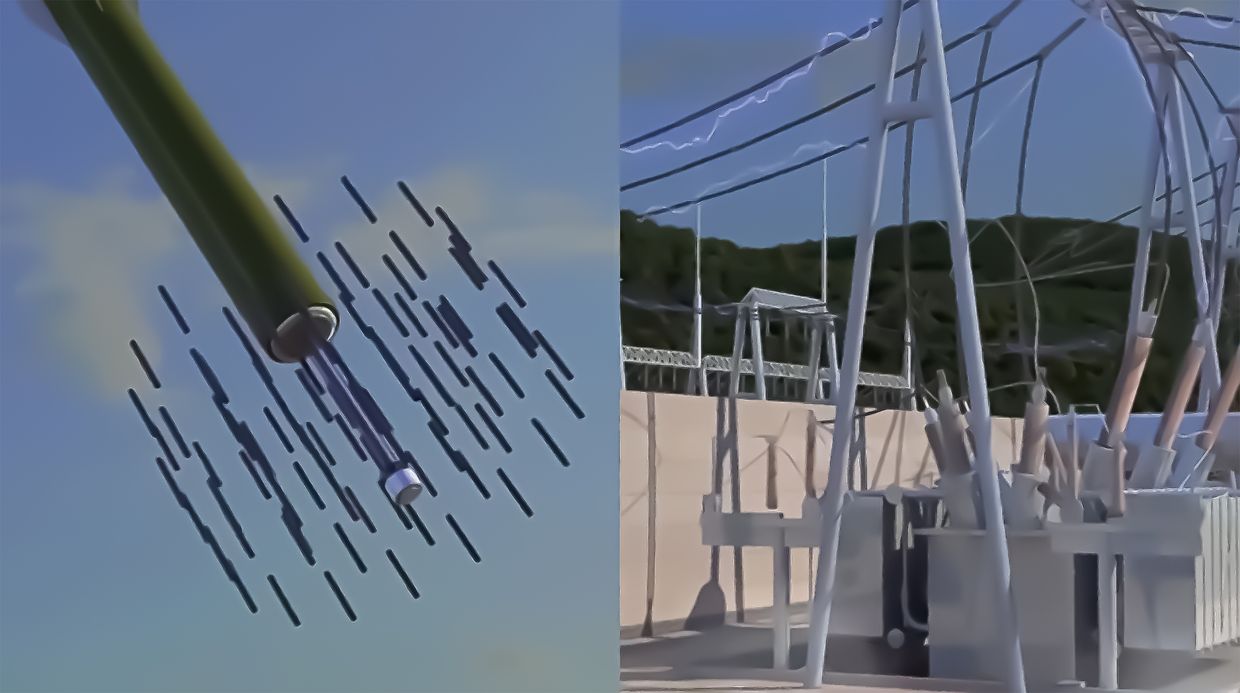
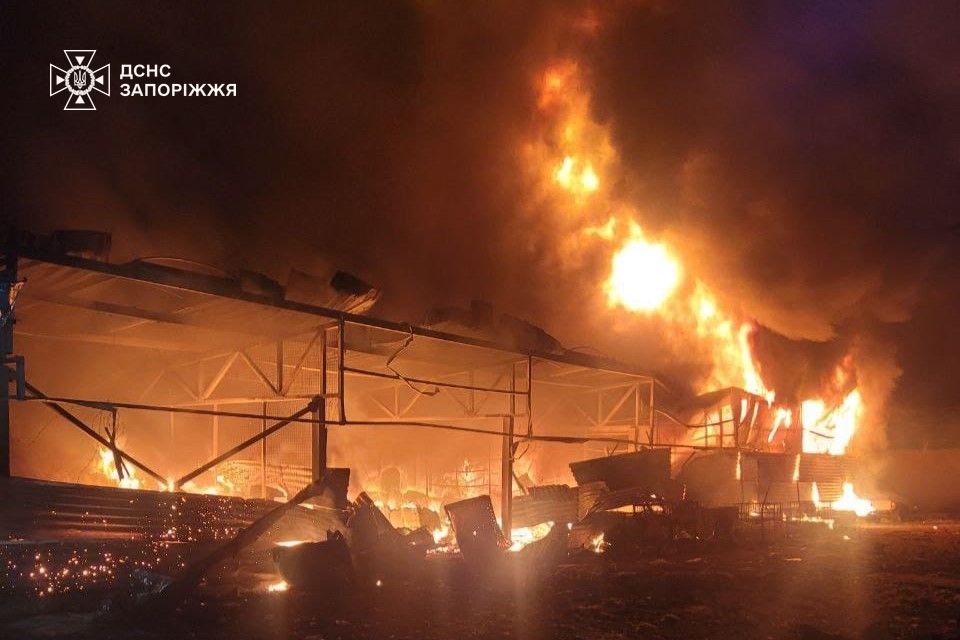

Editor's note: The story was updated with the latest reports from Mykolaiv and Sumy.
Russian attacks against Ukraine have killed at least six civilians and injured at least 25 others over the past day, regional authorities reported on July 6.
Russian forces launched four S-300 anti-aircraft missiles from Russia's Kursk Oblast and 157 Shahed drones from Russia's Shatalovo, Millerovo, and Primorsk-Akhtarsk airfields, as well as from Russian-occupied Crimea, against Ukraine overnight, according to Ukraine's Air Force.
Ukraine's air defense shot down 98 drones, while another 19 disappeared from radar without causing any damage, according to the statement. Drones that disappear from radar before reaching their targets are often decoys that Russia launches alongside real drones to overwhelm Ukraine's air defense.
In Kharkiv Oblast, Russian forces attacked 13 settlements, killing two people and injuring 11 others, Governor Oleg Syniehubov reported.
An 8-year-old boy was killed, while a 3-year-old boy, a 40-year-old man, and a 36-year-old woman suffered injuries in the village of Odnorobivka.
In the town of Kupiansk, a 59-year-old man was killed, while a 56-year-old man, a 57-year-old woman, and two women aged 65 were injured due to the Russian strikes.
In Kharkiv, the regional capital, a 46-year-old woman and a 2-year-old girl suffered injuries.
The casualties were also reported in the villages of Prykolotne and Shyroke, where a 66-year-old man and a 27-year-old woman were injured.
In Donetsk Oblast, Russian forces killed a person in the town of Myrnohrad, and another person was killed in the village of Andriivka, according to Governor Vadym Filashkin.
In Andriivka, two people suffered injuries. Two more people were injured in the town of Siversk, and another one in the city of Pokrovsk.
In Kherson Oblast, Russia targeted 32 settlements, including the regional center of Kherson, over the past day. As a result of the attacks, two people were killed and three others were injured, Governor Oleksandr Prokudin reported.
In Mykolaiv Oblast, Russian drones attacked the port infrastructure in the regional center of Mykolaiv, damaging the power grid and warehouses.
A 31-year-old woman was injured and hospitalized, while a 35-year-old man, who also suffered injuries in the attack, was treated at the scene, according to Governor Vitalii Kim.
In Sumy Oblast, a Russian FPV drone attacked the Khotyn community, hitting a car and injuring a 49-year-old man, the local military administration reported. He was hospitalized.
In Dnipropetrovsk Oblast, a 39-year-old woman was injured in the attack against the Nikopol district. Russia targeted the area with FPV (first-person-view) drones and artillery, according to Governor Serhii Lysak.
In Zaporizhzhia Oblast, Russian strikes injured an 89-year-old woman in the village of Yurkivka, the local military administration reported.
In Kyiv Oblast, Russia attacked the Vyshhorod district, injuring a 35-year-old man. He suffered shrapnel wounds, the local military administration reported.
In Poltava Oblast, Russian drones struck the city of Kremenchuk, hitting an enlistment office and a neighboring house. The attack caused a fire, but no casualties were reported, according to the local military administration.
Ukraine's Emergency Service also reported that Russia had carried out double-tap attacks in the cities of Kharkiv and Kherson when rescuers arrived at the impact sites. As a result of the attacks, tanker trucks were damaged, but no rescuers were injured.
 The Kyiv IndependentTim Zadorozhnyy
The Kyiv IndependentTim Zadorozhnyy
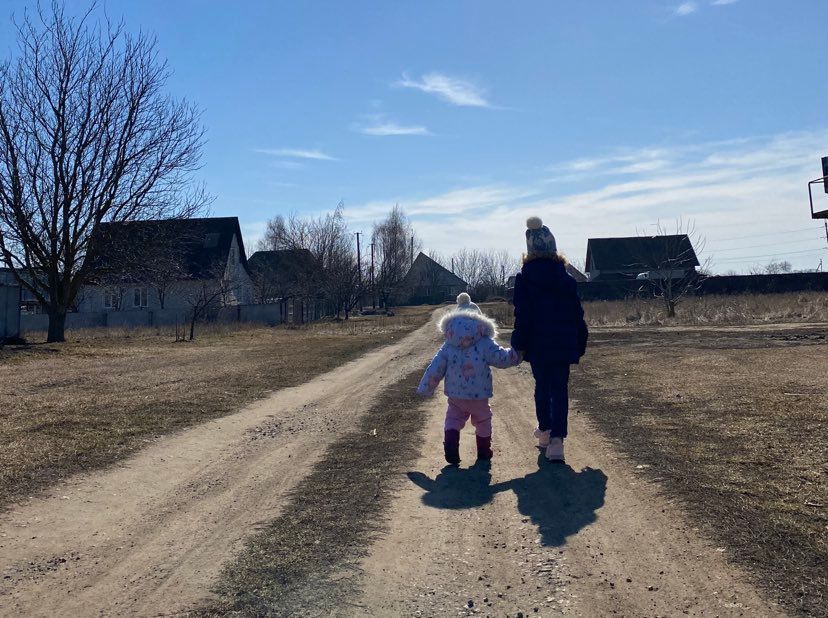

Life for children in Ukraine has become increasingly dangerous and deadly, according to the latest U.N. figures, which show a threefold jump in the number of deaths and injuries among children over the three months ending in May.
From March through May, 222 children were killed or injured, compared to 73 in the preceding three months, according to a press release from the U.N. Humanitarian Aid Organization for Children (UNICEF) on July 4.
The statement noted that "the ongoing use of explosive weapons in populated areas has been particularly deadly and destructive."
"There is no respite from the war for children across Ukraine," UNICEF Regional Director for Europe and Central Asia, Regina De Dominicis, said. "The situation for children is at a critical juncture, as intense attacks continue to not only destroy lives but disrupt every aspect of childhood."
In April alone, UNICEF noted, 97 children were killed or maimed, which was the highest figure that the U.N. has been able to verify since June 2022. Among the attacks in April was a strike on a playground in Kryvyi Rih, which killed nine children.
Recent months have seen some of the war's deadliest attacks on civilians, as Russia steps up its aerial strikes on civilian areas and launches record numbers of drones. Russia has dramatically increased its production of these weapons and is now capable of launching in a single night as many drones as it did over an entire month in early summer 2024.
At the same time, the U.S has halted a shipment of weapons that includes air defense missiles, which Ukraine critically needs to defend itself from Russia's attacks.
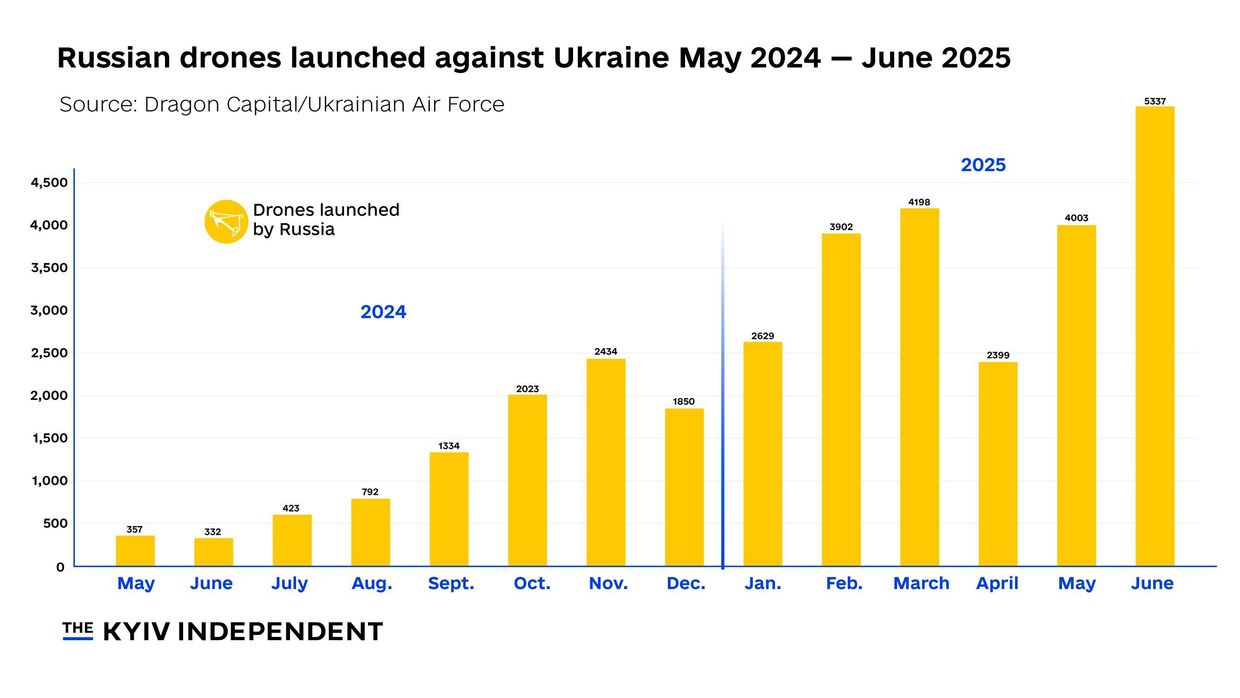
 The Kyiv IndependentThe Kyiv Independent news desk
The Kyiv IndependentThe Kyiv Independent news desk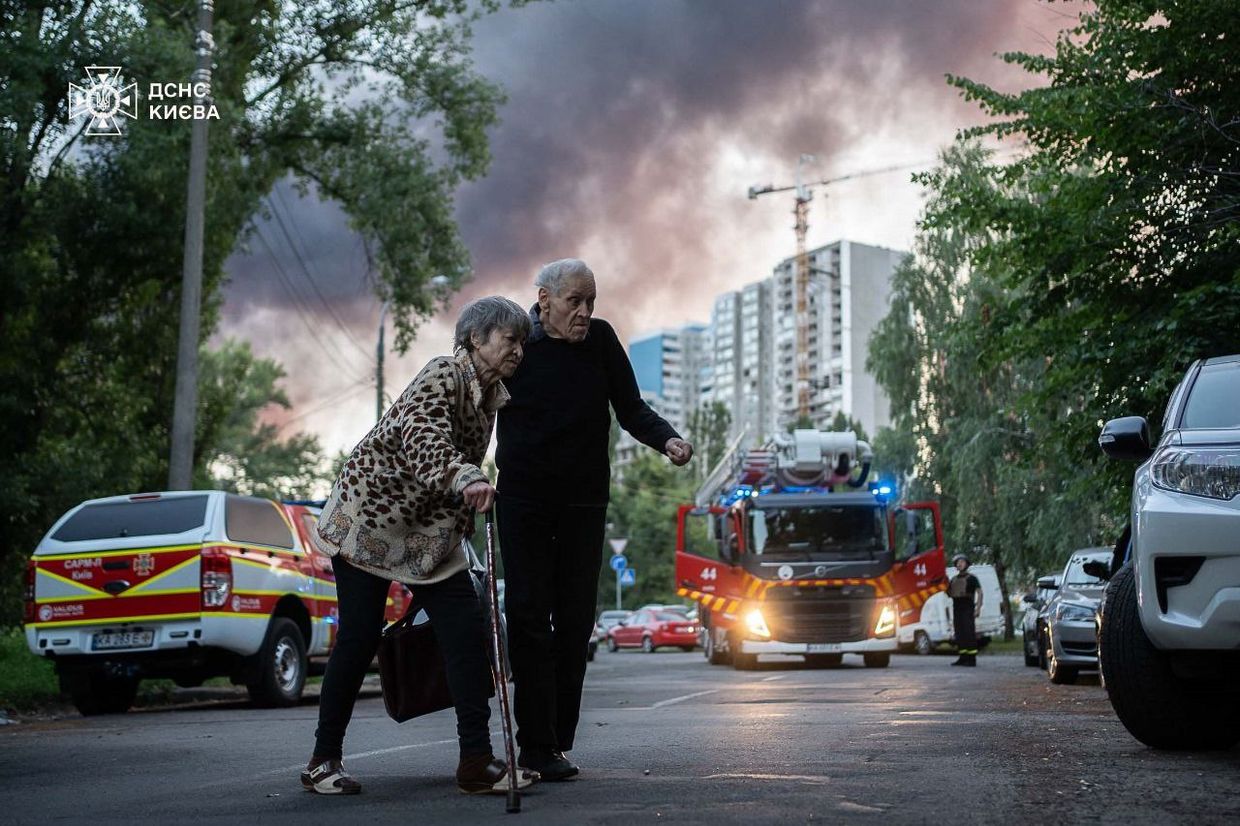
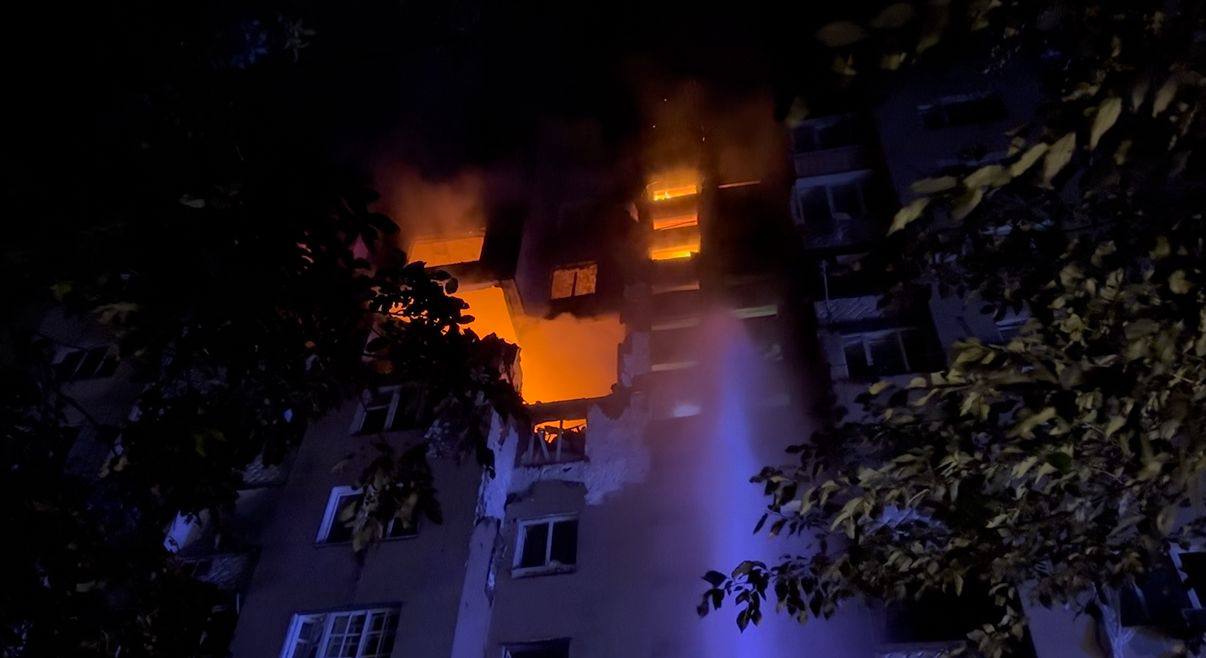

At least three people were killed and 34 injured across Ukraine in Russian drone and missile attacks, Ukrainian regional officials reported on July 3.
Ukraine's Air Force reported that Russia used 52 drones launched from several directions, including Oryol, Millerovo, and Primorsko-Akhtarsk. Air defenses destroyed 40 of them, including 22 shot down and 18 jammed electronically.
In Donetsk Oblast, three people were killed and at least nine injured in multiple settlements, Governor Vadym Filashkin said. Damage was reported to residential buildings, cars, and utility infrastructure across Pokrovsk, Kostyantynivka, and other towns.
In Kherson Oblast, Russian forces shelled over 30 towns and villages, wounding nine civilians, Governor Oleksandr Prokudin said. Strikes hit both residential neighborhoods and critical infrastructure. One person was hospitalized in Kherson city after being hit by a drone.
In Dnipropetrovsk Oblast, seven civilians were injured, including a 17-year-old girl, as Russia used artillery and drones to strike Nikopol and Synelnykove districts, Governor Serhii Lysak said. Fires broke out in wheat fields, and residential buildings and infrastructure were damaged.
In Odesa, five people were injured, including two children aged 7 and 9, in a Russian drone strike on a residential building, Governor Oleh Kiper reported. Several apartments were destroyed or damaged.
In Zaporizhzhia Oblast, one person was injured and nine settlements were struck over 430 times in the past 24 hours, Governor Ivan Fedorov said. The attacks included airstrikes, FPV drones, and artillery, causing damage to houses and infrastructure.
In Kharkiv Oblast, two people were injured in separate strikes, Governor Oleh Syniehubov said. Civilian infrastructure was damaged in multiple areas, including houses and vehicles.
 The Kyiv IndependentNatalia Yermak
The Kyiv IndependentNatalia Yermak
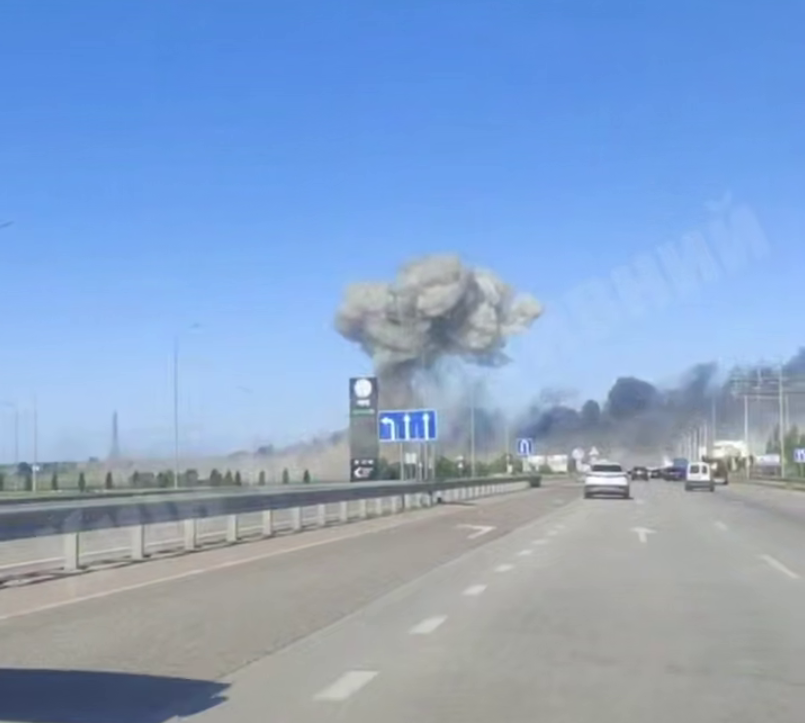

Editor's note: This is a developing story and is being updated.
Two people have been killed and 80 others injured after explosions rang out beside a highway near the city of Zhytomyr, local officials reported.
The cause of the explosions was not immediately clear and is under investigation, Ukraine's National Police said.
Zhytomyr City Council reported that the explosions occurred unspecified facility located close to the M-06 highway near Zhytomyr. Serhii Sokalskyi, head of the Hlubochytska community in Zhytomyr Oblast, claimed that the explosions may have rang out at an industrial warehouse near the town of Berezyna — although those details have yet to be confirmed.
Vitaliy Bunechko, head of the Zhytomyr Oblast Military Administration, said that multiple homes and powerlines had been damaged in the explosions, while also confirming the closure of the highway as the investigation carries on.
Videos of the explosions posted to social media show large clouds of smoke billowing out of the area of the explosions.
No information was provided on the status of the injured victims. Emergency responders are currently on-scene.
Located about 140 km west of Kyiv, Zhytomyr has become an occasional target of Russian missile and drone attacks. In recent months, Russia has intensified its attacks on Ukrainian cities, using upwards of 500 drones in attacks.
Despite the increase in attacks, support from Ukraine's largest defense partner, the United States, has continued to wane. Politico reported on July 1, citing sources familiar with the matter, that the U.S. Defense Department (DOD) has halted shipments of some air defense missiles and other weapons previously promised to Kyiv out of concerns over the size of U.S. stockpiles.
 The Kyiv IndependentThe Kyiv Independent news desk
The Kyiv IndependentThe Kyiv Independent news desk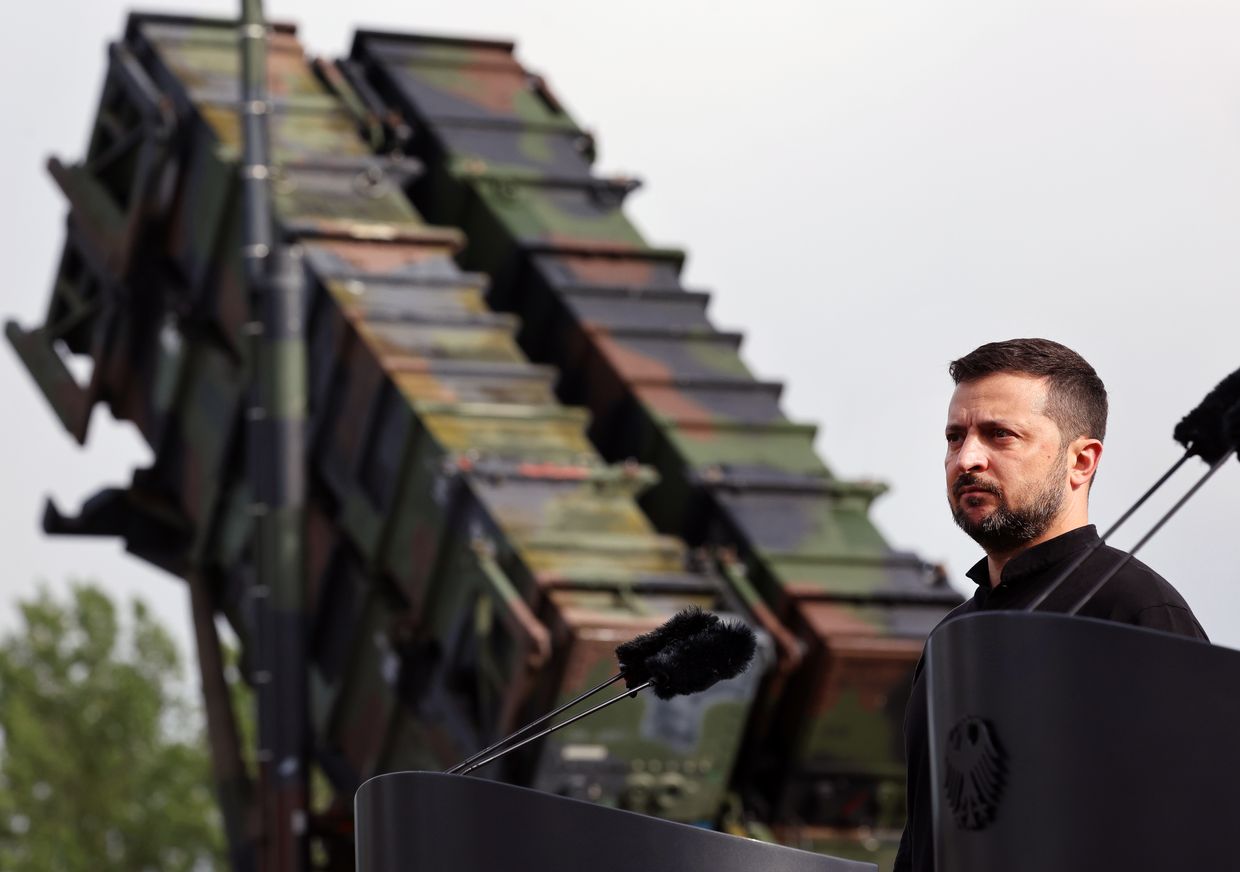
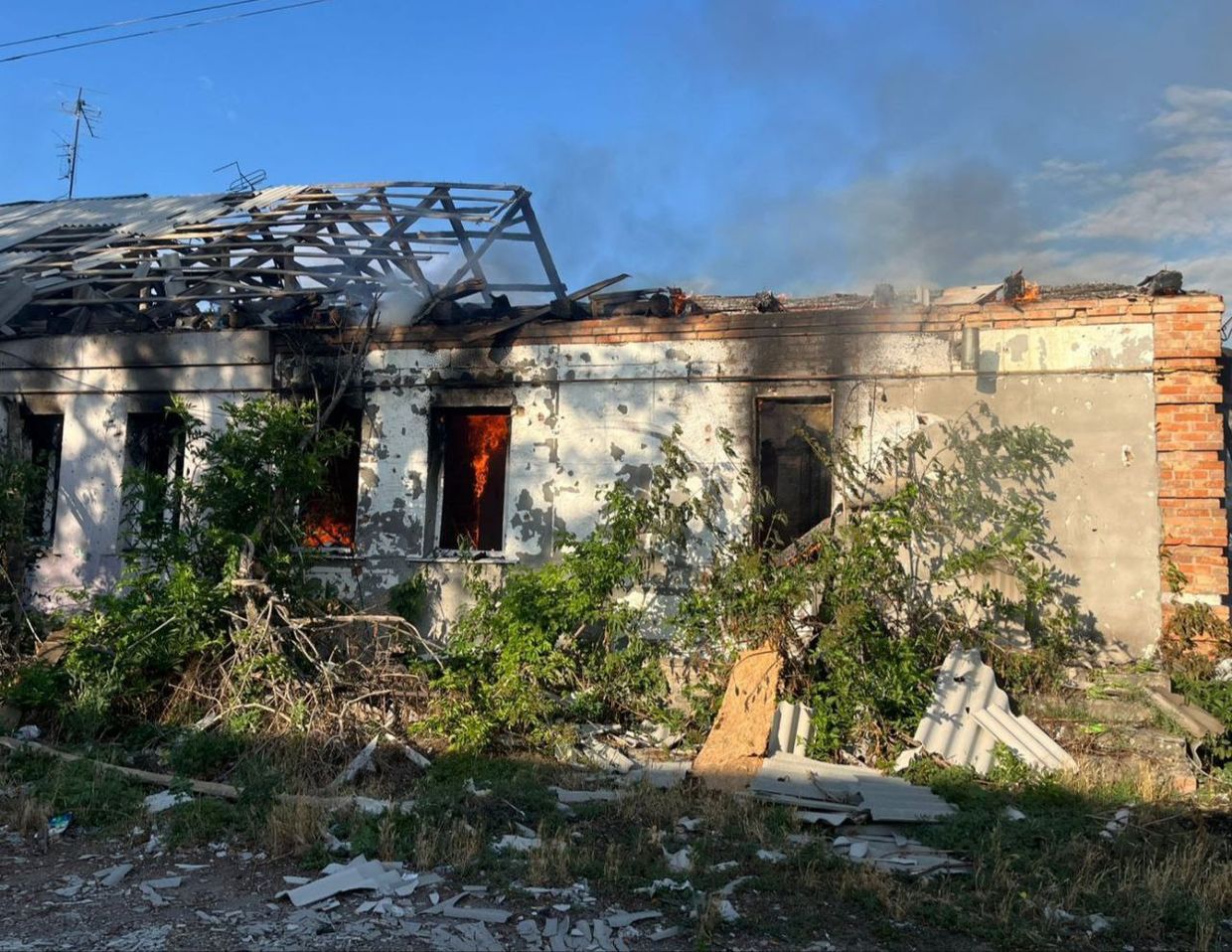

At least two civilians were killed and 33 were injured in Russian attacks against Ukraine over the past 24 hours, according to local governors.
Ukraine's Air Force said Russia launched 114 Shahed-type and decoy drones overnight from multiple directions, as well as four S-300 missiles. Air defenses shot down 40 drones, while 39 disappeared from radars or were intercepted by electronic warfare.
In Kherson Oblast, Russian forces shelled a hospital in Kherson city late on July 1, injuring eight people, including patients and medical staff, Governor Oleksandr Prokudin said.
Two other people were injured elsewhere in the region over the past day. Attacks damaged residential buildings, a farm, a business, and vehicles across more than 30 settlements.
In Kharkiv Oblast, four people were injured in attacks on Kharkiv city and six other communities, Governor Oleh Syniehubov reported. Russian forces used guided aerial bombs, various drones, and artillery. Civilian infrastructure, including houses, a transport stop, an emergency medical facility, and businesses, was damaged or destroyed.
In Donetsk Oblast, two civilians were killed and 10 others injured by Russian attacks on July 1, according to Governor Vadym Filashkin. In the city of Sloviansk, a mail terminal operated by Nova Poshta, Ukraine’s largest postal service, was destroyed. No employees were injured, according to an official statement.
In Dnipropetrovsk Oblast, five people were injured, four of whom were hospitalized, after a drone strike on Nikopol, Governor Serhii Lysak said.
Russian attacks damaged a private enterprise in Kryvyi Rih and a farm in the Samar district. Fires were reported in both locations. Drone and artillery strikes also hit residential and infrastructure targets in Nikopol and Pokrovske communities.
In Zaporizhzhia Oblast, four civilians were injured in Russian attacks on Vasylivka and Polohy districts, Governor Ivan Fedorov reported. Over the day, Russian forces launched 376 strikes across 14 settlements, using aircraft, drones, multiple rocket launchers, and artillery.
 The Kyiv IndependentOleksiy Sorokin
The Kyiv IndependentOleksiy Sorokin
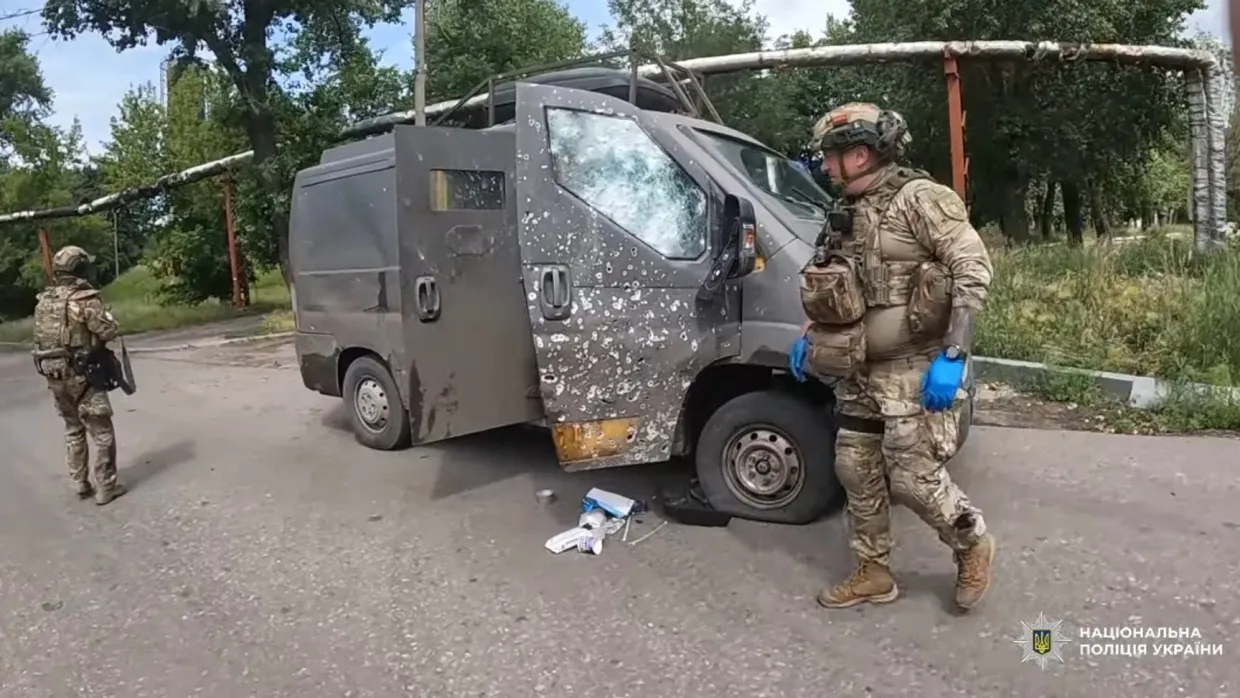

The Russian army attacked an evacuation vehicle carrying three wounded civilians, which resulted in the death of one of them, Ukraine's National Police reported on July 1.
Russia has for months focused its offensive efforts on the embattled town of Pokrovsk in Donetsk Oblast and has recently been escalating attempts to break through to neighboring Dnipropetrovsk Oblast, a region that has not yet seen combat.
According to the police, Russian forces attacked the evacuation vehicles provided by chaplains three times: at the entrance to the city, in the city center, and during the evacuation of civilians from Pokrovsk. The police called Russia's actions "targeted hunting."
The police picked up one injured person in the city, and the other two — on the way to the hospital. In the meantime, the Russian army hit the car with a Molniya drone. As a result of the attack, one of the police officers was injured.
As the evacuation vehicle came under fire, one of the injured could not be brought to the hospital in time and died of blood loss.
"We called for reinforcements and sent the injured civilian with them, hoping for a miracle. But it did not happen, Russia took another life," Hennadii Yudin, head of the "White Angel" police unit, said.
Another injured man, who was evacuated with a shrapnel wound, is undergoing treatment, the police said.
Commander-in-Chief Oleksandr Syrskyi reported on June 27 that Russia has amassed "about 111,000 personnel" in the Pokrovsk sector, but Ukrainian forces are holding the line.
Syrskyi's statement came as Russian President Vladimir Putin claimed Moscow is "ready" for a third round of peace talks with Kyiv.
Russia's so-called "peace memorandum" demands that Ukraine recognize Russia's annexation of Crimea, as well as Kherson, Donetsk, Zaporizhzhia, and Luhansk oblasts — none of which are fully under Moscow's control.
 The Kyiv IndependentAsami Terajima
The Kyiv IndependentAsami Terajima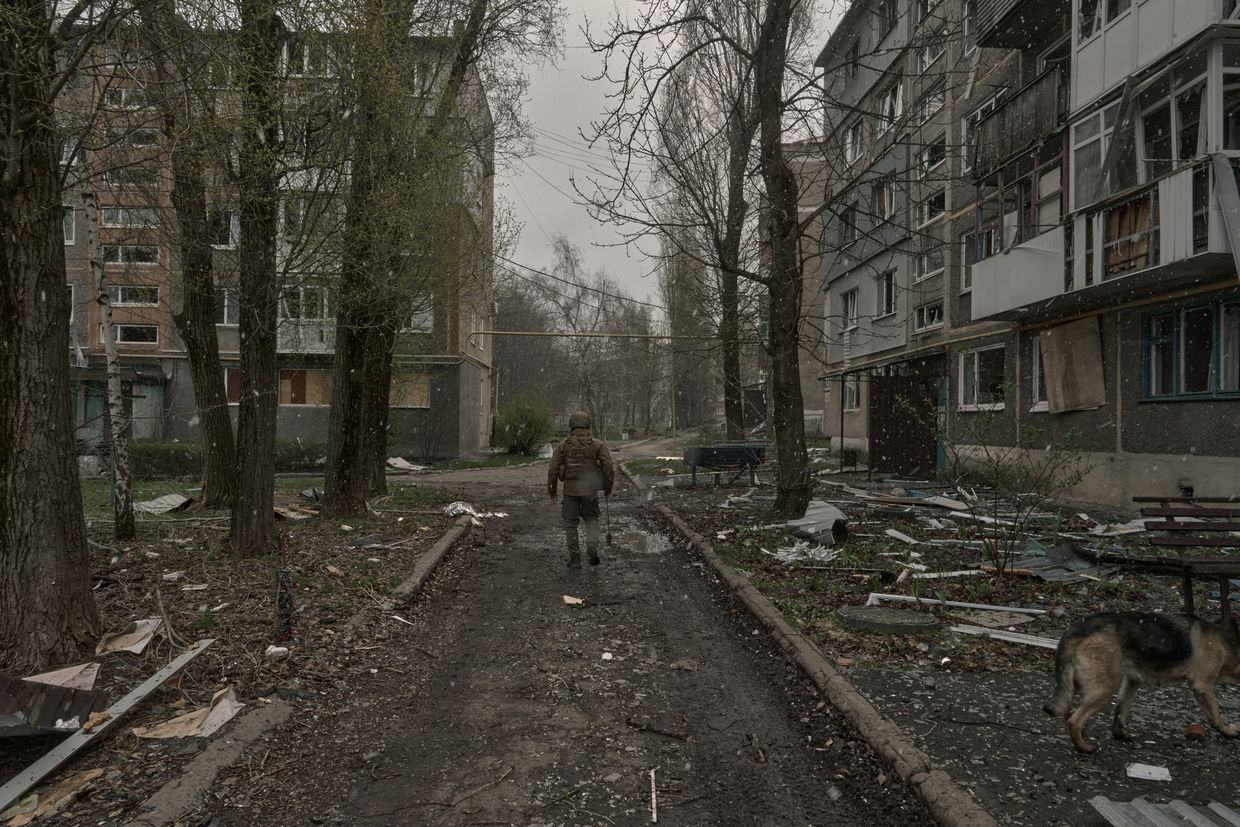
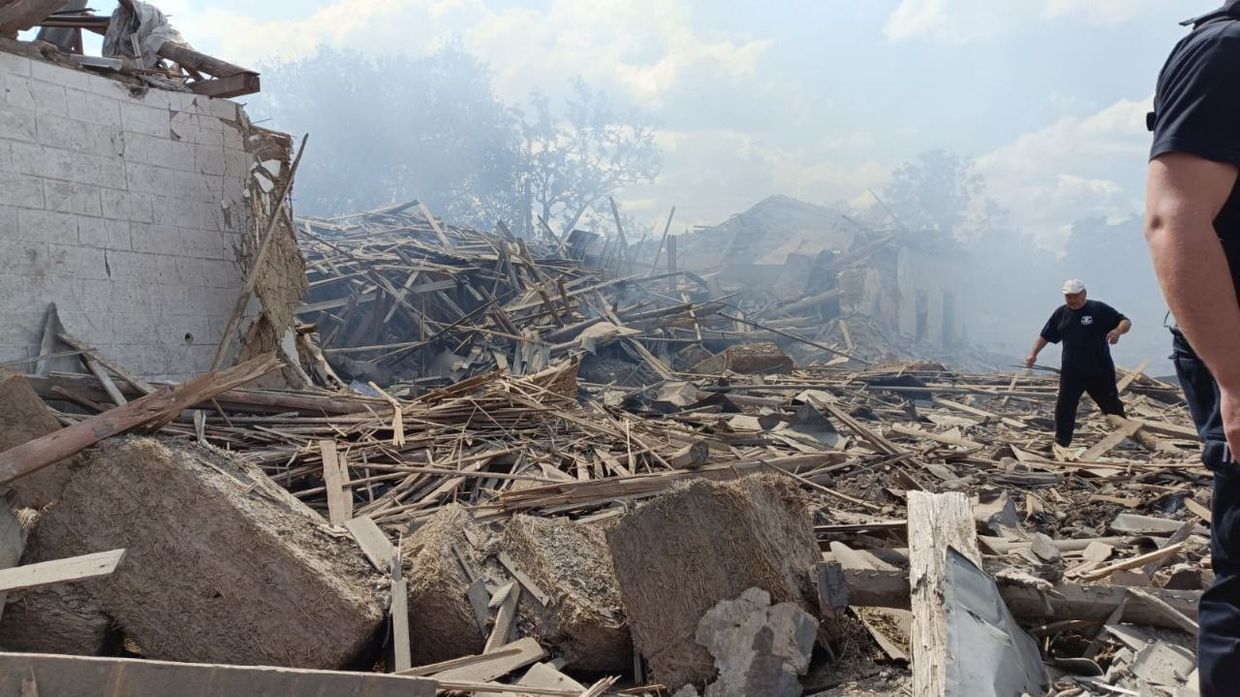

Editor's note: This is a developing story and is being updated. The article contains graphic footage.
A Russian missile attack against the village of Huliaipole in Dnipropetrovsk Oblast on July 1 resulted in deaths and injuries, the Southern Defense Forces reported.
"As a result of the strike, a cultural center, two shops, and several private homes were destroyed or damaged," the statement read.
Russia launched two ballistic missiles, likely Iskander-M, against the village at 9:15 a.m. local time, the military reported.
The strike was reported earlier on July 1 by Serhii Lysak, the regional governor. No exact casualty figures have been provided so far, and officials promised detailed information at a later date.


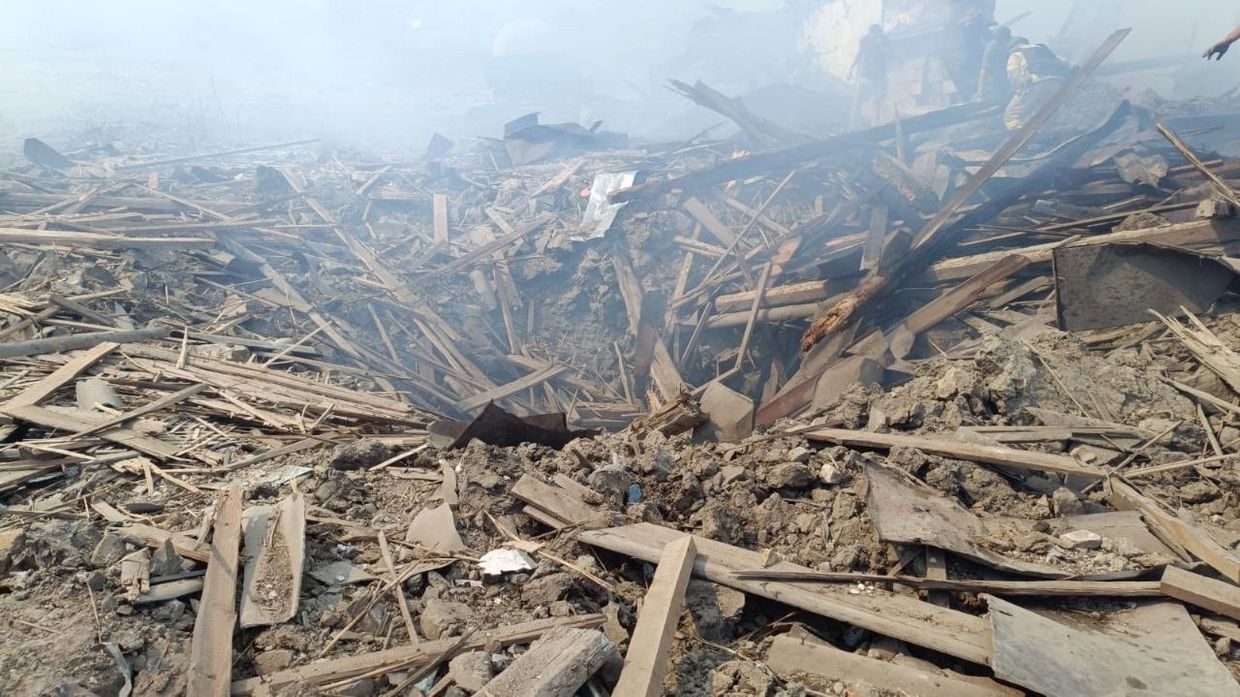

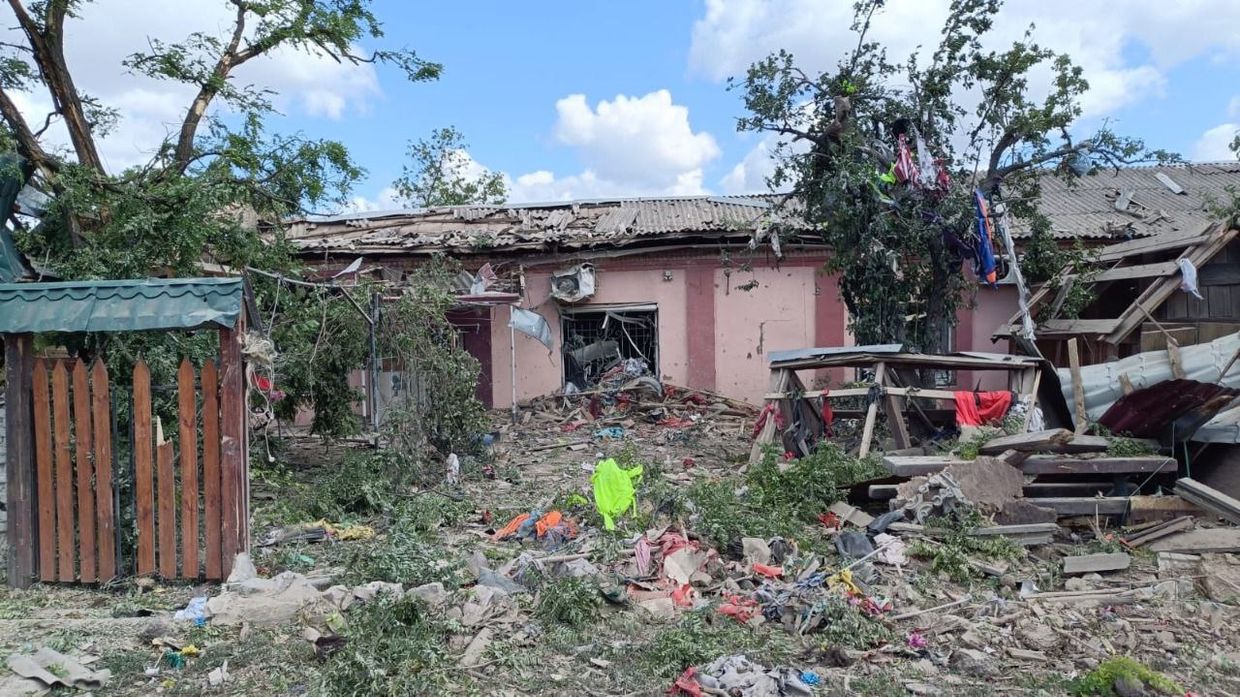
Huliaipole, with a pre-war population of around 1,200, lies in the western part of eastern Dnipropetrovsk Oblast, roughly 70 kilometers (40 miles) from the front line.
"Russia once again confirms its status as a terrorist state. It kills innocent civilians," the military said in a statement.
Dnipropetrovsk Oblast is regularly targeted by Russian drone and missile attacks. Moscow's ground troops have also been attempting to break into the region, though Kyiv has denied Russian claims that they had been successful.

 The Kyiv IndependentChris York
The Kyiv IndependentChris York
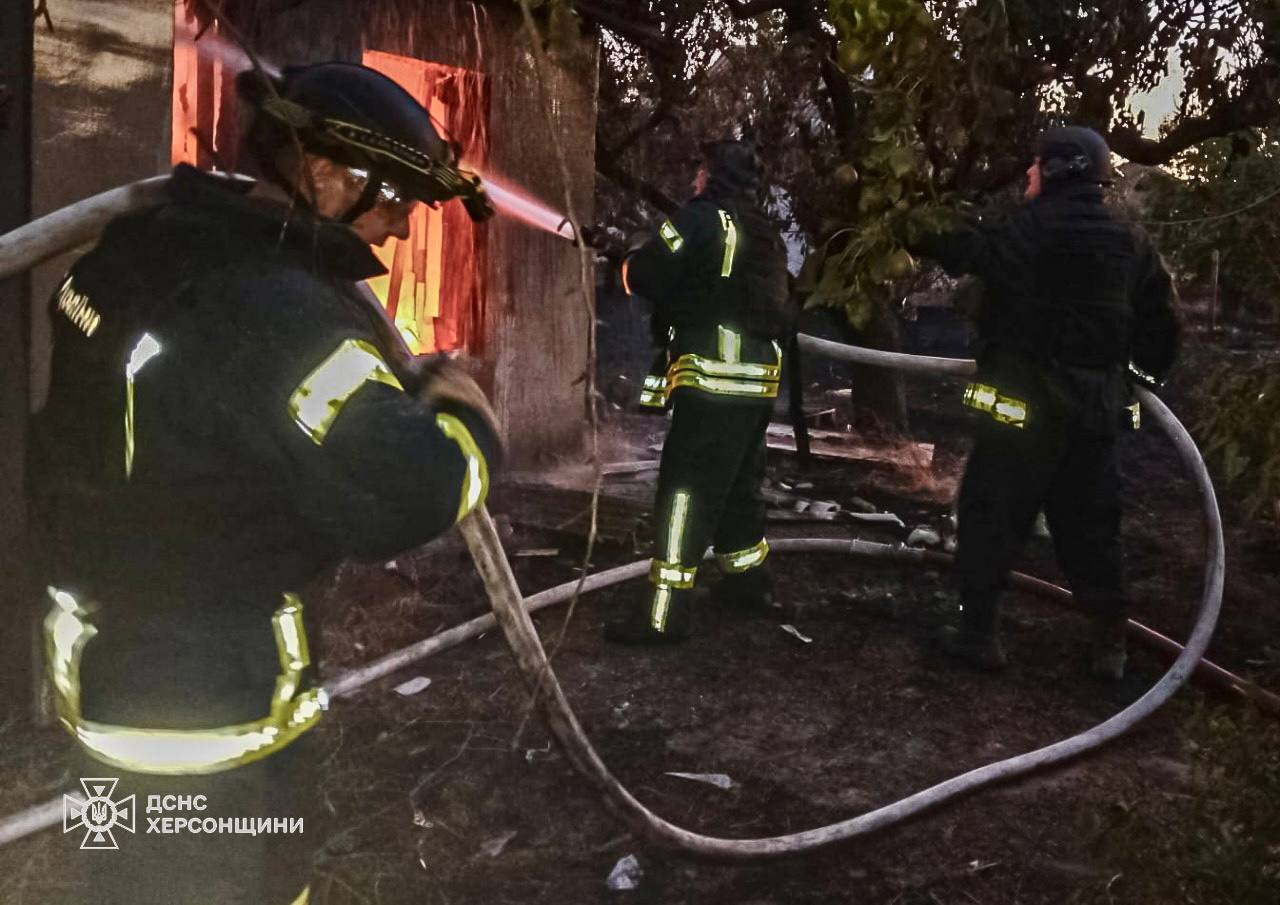

Russian strikes across Ukrainian regions killed at least four civilians and injured at least 15 over the past day, regional authorities reported on July 1.
Russia launched 47 Shahed-type attack drones and decoys against Ukraine overnight, the Air Force reported. Ukrainian air defenses shot down 14 drones, while 33 were intercepted by electronic warfare or disappeared from radars, according to the statement.
Russian attacks injured three civilians in Donetsk Oblast, Governor Vadym Filashkin reported.
In Kharkiv Oblast, two women aged 60 and 81 were injured during a Russian attack on the Tsykruny village, Governor Oleh Syniehubov reported.
Russian attacks across Kherson Oblast killed two people and injured five, said the regional governor, Oleksandr Prokudin. Three high-rise buildings and eight houses were damaged.
In Mykolaiv Oblast, a 45-year-old man was killed and a 37-year-old woman was injured during Russian shelling of the Kutsurub community on June 30, Governor Vitalii Kim reported. Houses, two schools, and a shop were damaged, and a fire erupted because of the attack.
A 75-year-old man was killed and his 76-year-old wife was injured during another artillery attack against the community on the morning of July 1, Kim said.
Two civilians were injured in Russian attacks against Sumy Oblast, the regional military administration reported.
In Zaporizhzhia Oblast, a 56-year-old man was wounded when Russia attacked the Polohy district, according to Governor Ivan Fedorov.
 The Kyiv IndependentChris York
The Kyiv IndependentChris York
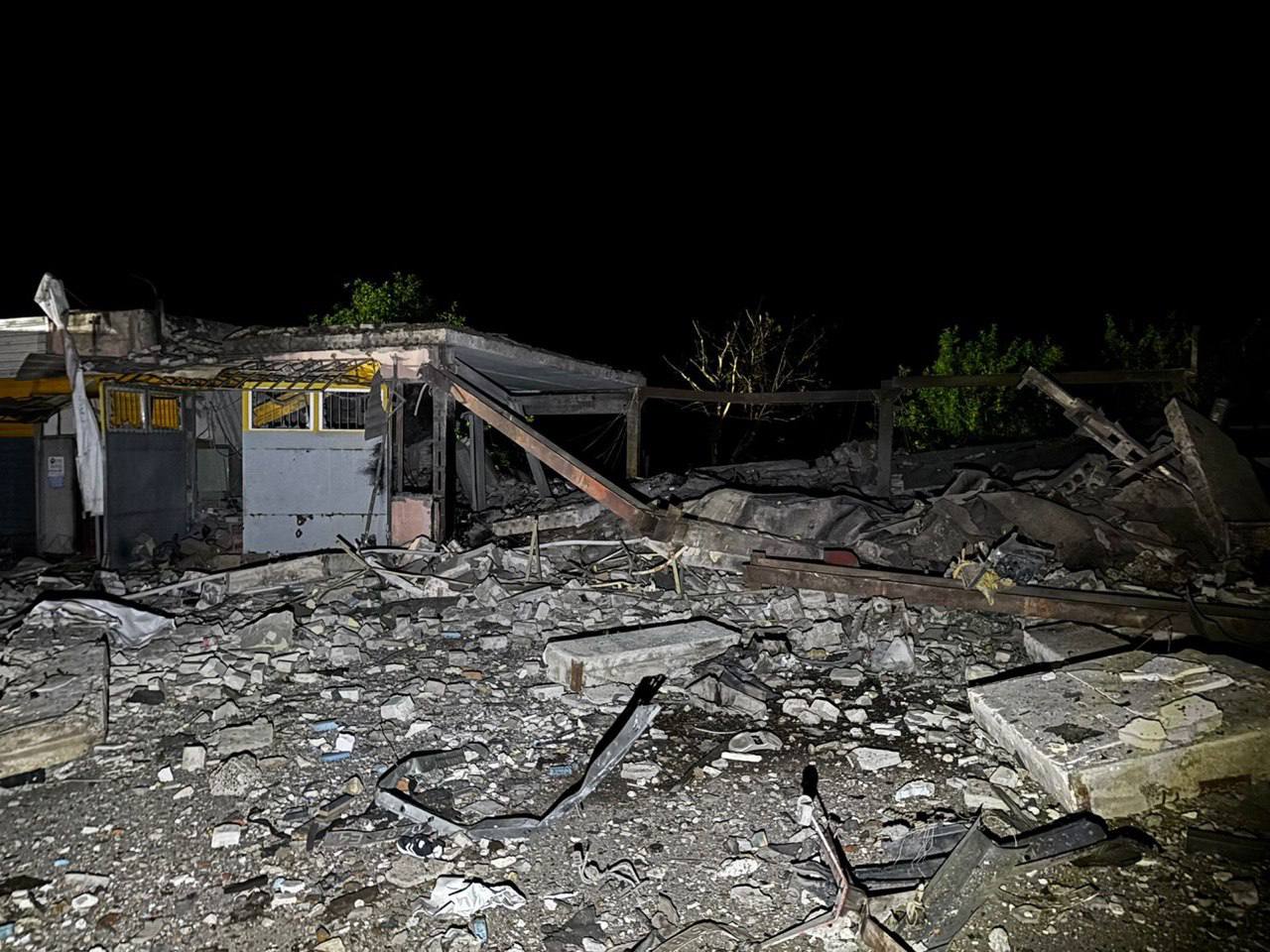

Russian attacks across multiple Ukrainian regions over the past 24 hours have killed at least six people and injured 26 others, according to local officials. The strikes involved drones, artillery, and guided bombs, hitting residential areas and critical infrastructure.
According to Ukraine's Air Force, Ukrainian air defense hit 74 out of 107 drones launched overnight by Russia.
In Kharkiv Oblast, two people were killed and eight injured following attacks on six settlements, Governor Oleh Syniehubov said. Damage was reported to houses, vehicles, and civilian infrastructure across Kharkiv, Kupiansk, and Chuhuiv districts.
In Kherson Oblast, Russian forces struck residential areas and civilian infrastructure in over two dozen localities, killing two people and injuring eight others, according to Governor Oleksandr Prokudin. Damage included houses, utility systems, and communications infrastructure.
In Zaporizhzhia Oblast, one person was killed in Vasylivka district. Governor Ivan Fedorov said Russian forces launched 375 strikes on 10 settlements, damaging houses and vehicles.
In Dnipropetrovsk Oblast, three people were injured in Kryvyi Rih following drone strikes and artillery attacks, Governor Serhii Lysak reported. Fires broke out, and damage was recorded at a farm and in residential areas.
In Donetsk Oblast, at least one person was killed and four others injured, Governor Vadym Filashkin said. Multiple residential buildings, a church, and a pharmacy were damaged across Pokrovsk, Kramatorsk, and Bakhmut districts.
In Sumy Oblast, Russian attacks injured three civilians, regional authorities said. Nearly 80 strikes targeted 29 settlements, damaging houses, educational institutions, and public buildings.
 The Kyiv IndependentAnna Fratsyvir
The Kyiv IndependentAnna Fratsyvir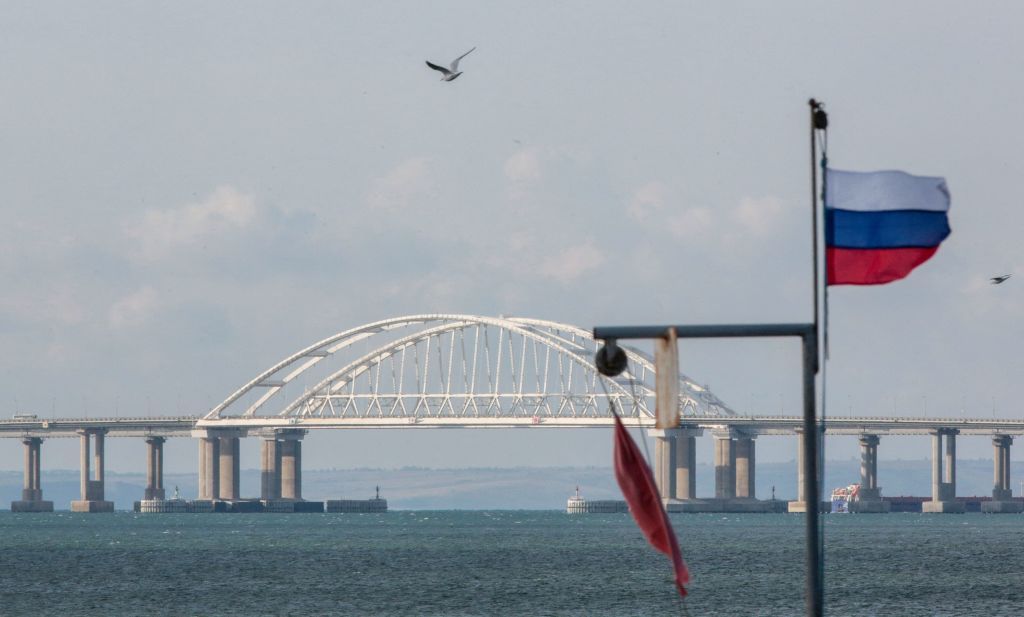
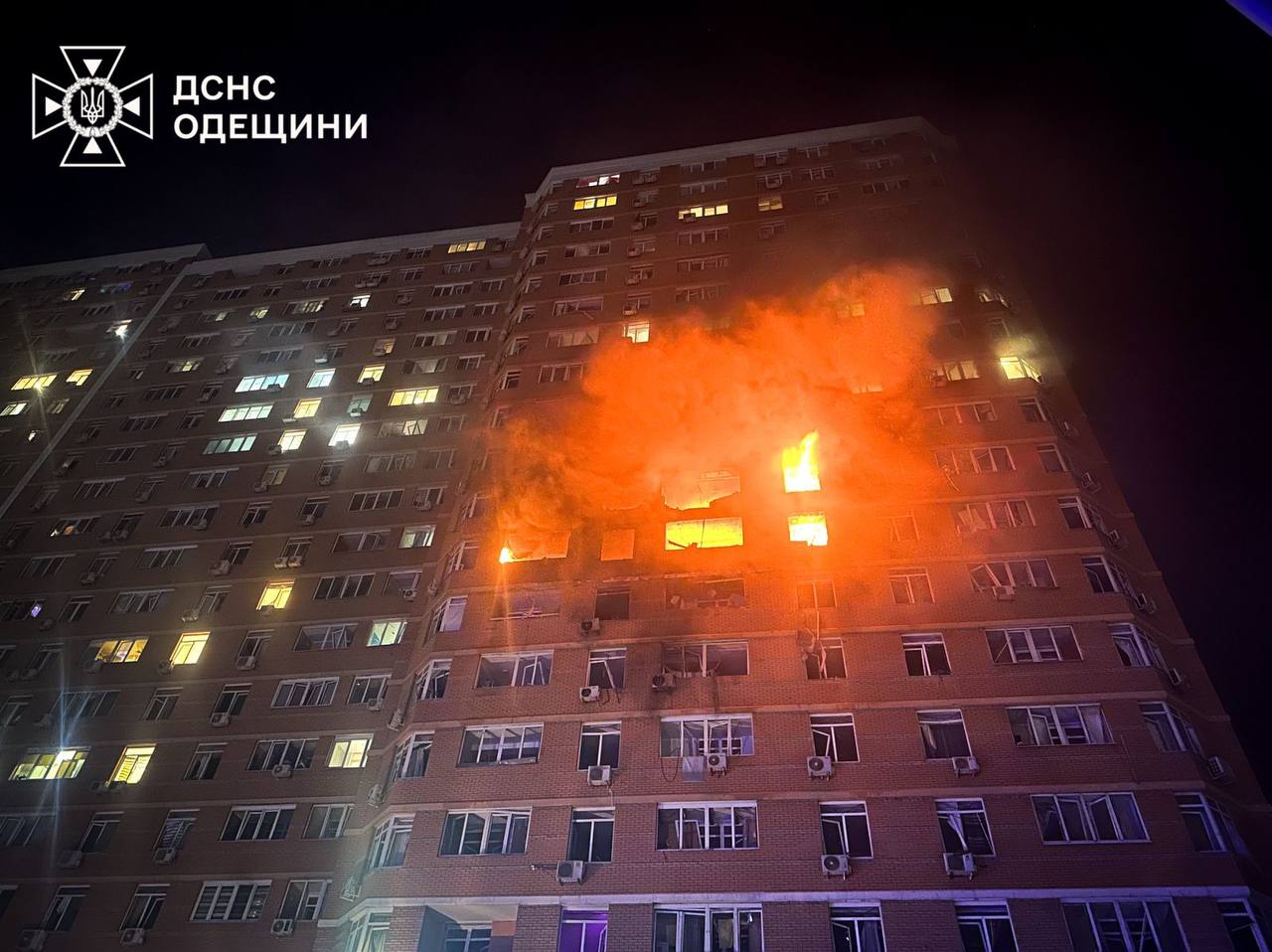

Editor's Note: This is a developing story.
Russia attacked the southern city of Odesa overnight on June 28, killing two people and injuring at least 14 others, Ukraine's State Emergency Service reported.
The drone attack hit a 21-story building, causing a fire on the 7th, 8th, and 9th floors that left residents trapped in their apartments. First responders rescued five people, including a small child.
Two people, a married couple, were killed in the attack, Odesa Oblast Governor Oleh Kiper reported. Emergency workers recovered their bodies from the damaged building.
At least 14 other civilians were injured, including three children. Both are receiving treatment in medical facilities, Kiper said.
Ongoing air raid alarms throughout the night complicated rescue efforts, the State Emergency Service said.
Odesa, a port city on Ukraine's Black Sea coast with a population of around 1 million, has been a frequent target of Russian attacks since the full-scale invasion. A massive Russian drone strike on June 20 killed one civilian and injured 14 others, including three first responders.
Russian missile and drone attacks on Ukrainian cities have intensified dramatically in May and June.
 The Kyiv IndependentThe Kyiv Independent news desk
The Kyiv IndependentThe Kyiv Independent news desk
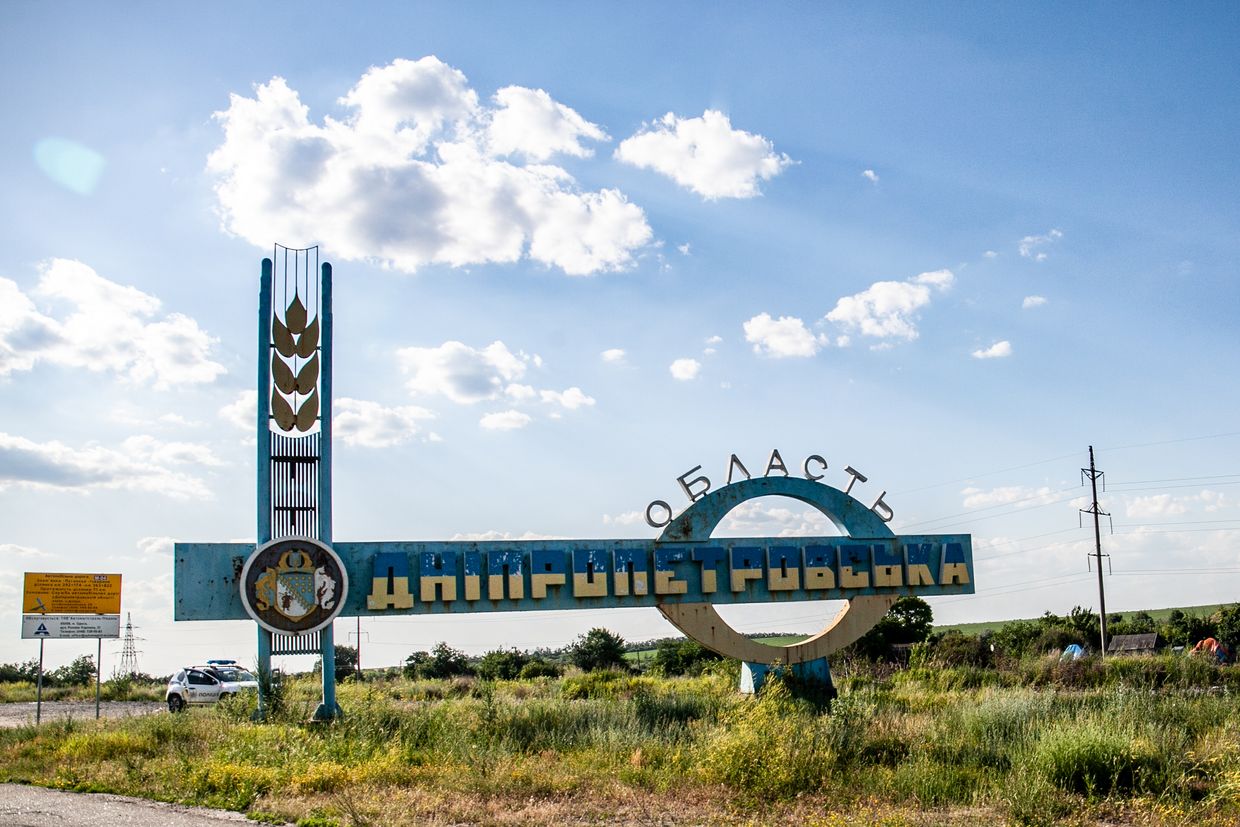

Editor's note: This is a developing story and is being updated.
A Russian missile strike on the city of Samar in Ukraine's Dnipropetrovsk Oblast on June 27 killed five people and injured at least 25 others, Governor Serhii Lysak said.
In a statement posted to Telegram, Lysak said most of the injured were hospitalized. Four of the victims are in serious condition, while the others sustained moderate injuries. A fire broke out following the strike, and emergency services are continuing to work at the site.
"We're doing everything possible to assist those affected," Lysak said.
The attack comes just days after Russia launched one of the deadliest assaults on Dnipropetrovsk Oblast. On June 24, missiles struck multiple locations in the regional capital of Dnipro and in the oblast, killing at least 21 people and injuring over 300 others.
The strike hit civilian infrastructure, a dormitory, a gymnasium, and a train traveling from Odesa to Zaporizhzhia, as well as the nearby town of Samarske. Two people were killed and 14 others wounded there. At least 100 victims of the Dnipro attack remain hospitalized, Lysak said.
 The Kyiv IndependentAbbey Fenbert
The Kyiv IndependentAbbey Fenbert


At least two civilians were killed and 13 were injured in Russian drone and missile attacks across Ukraine over the past day, local officials reported on June 27.
According to Ukraine's Air Force, Ukrainian air defense intercepted 365 of 371 incoming Russian air weapons, including 363 Shahed-type drones, two Kinzhal ballistic missiles, and six Kalibr cruise missiles.
In Kharkiv Oblast, Governor Oleh Syniehubov said one person was killed and four were wounded in Vovchanski Khutory and Pidlyman during a Russian attack. Infrastructure damage included houses and an agricultural facility. The region also endured heavy shelling.
In Donetsk Oblast, Governor Vadym Filashkin reported one death, while three people were injured across Pokrovsk, Kramatorsk, and Bakhmut districts. Damage was observed to houses, a farm, administrative buildings, gas pipelines, and vehicles.
In Kherson Oblast, Governor Oleksandr Prokudin said four people were injured as Russian drones and artillery struck social and residential infrastructure. Seven apartment buildings and 25 houses were damaged, along with utilities and vehicles.
In Zaporizhzhia Oblast, Governor Ivan Fedorov said one person was injured when an air-dropped bomb hit a settlement in the Huliaipole district.
In Kyiv Oblast, a person was injured near Fastiv during an overnight drone and missile attack. One house was damaged each in Boryspil and Fastiv districts, while a tire repair shop and five cars were hit in Bila Tserkva. No critical infrastructure was reportedly affected, and air defense forces shot down Russian drones and missiles.
 The Kyiv IndependentChris York
The Kyiv IndependentChris York
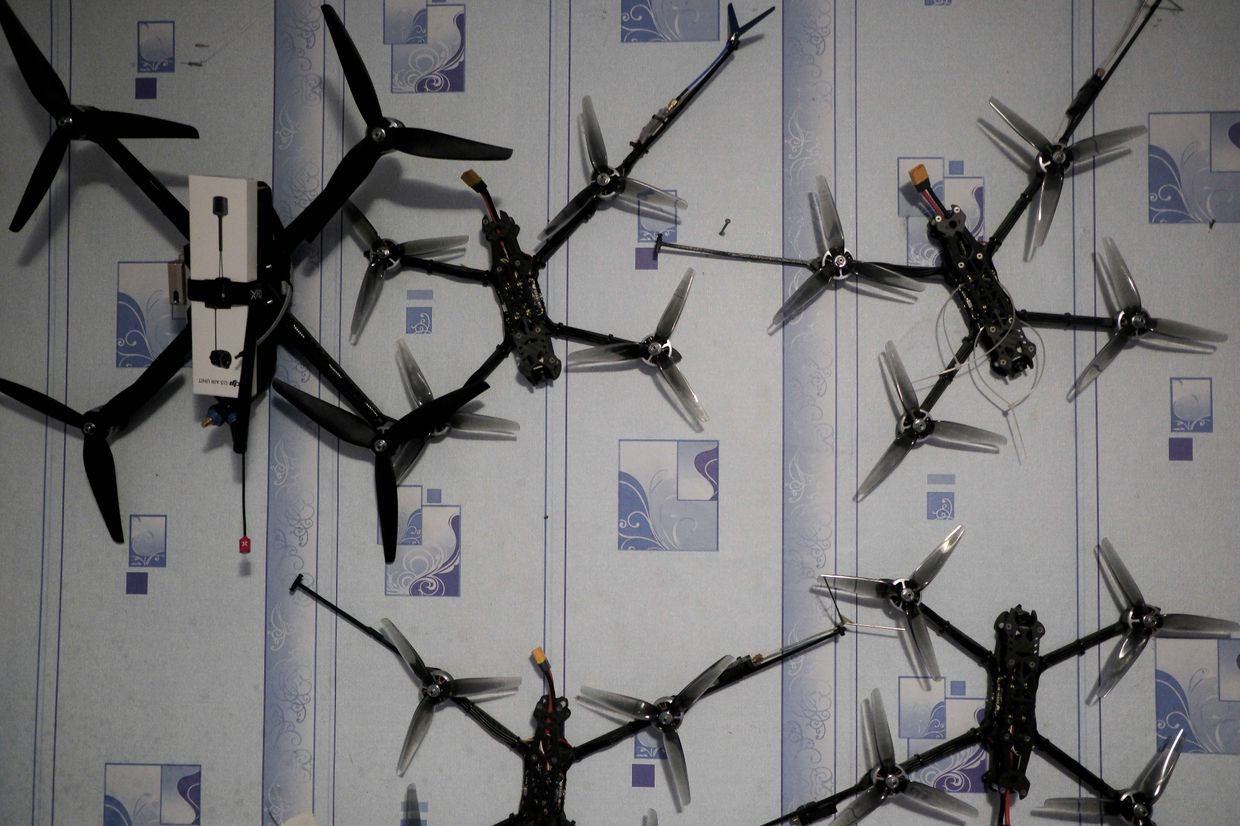

Short-range drone attacks have become one of the deadliest threats to civilians in Ukraine’s front-line regions, killing at least 395 people and injuring 2,635 between February 2022 and April 2025, according to a new bulletin by the UN Human Rights Monitoring Mission in Ukraine.
The report, "Deadly Drones: Civilians at Risk from Short-Range Drones in Frontline Areas of Ukraine," highlights the growing use of first-person-view (FPV) drones by Russian forces and their devastating impact on the civilian population.
The bulletin documents attacks in which drone operators deliberately targeted civilians engaging in daily activities — driving private cars, riding bicycles, walking outdoors, or evacuating others in clearly marked ambulances.
"Although individually less destructive than artillery or missiles, the sheer scale and increasing frequency of short-range drone attacks have made them one of the deadliest weapons in Ukraine," said Danielle Bell, head of the mission. "Over 3,000 civilian casualties — and the relentless frequency of these attacks — have not only caused immense human suffering but also instilled fear, severely disrupted daily life, and crippled access to essential services in several frontline communities."
The monitoring mission documented, verified, and analyzed 3,030 civilian casualties resulting from short-range drones between 24 February 2022 and 30 April 2025. The researchers conducted site visits to very high-risk areas, including the southern city of Kherson, Zolochiv in Kharkiv Oblast, and other front-line locations. Investigators interviewed survivors and witnesses of drone attacks, medical personnel, and humanitarian workers to assess the full impact of these strikes on civilian life.
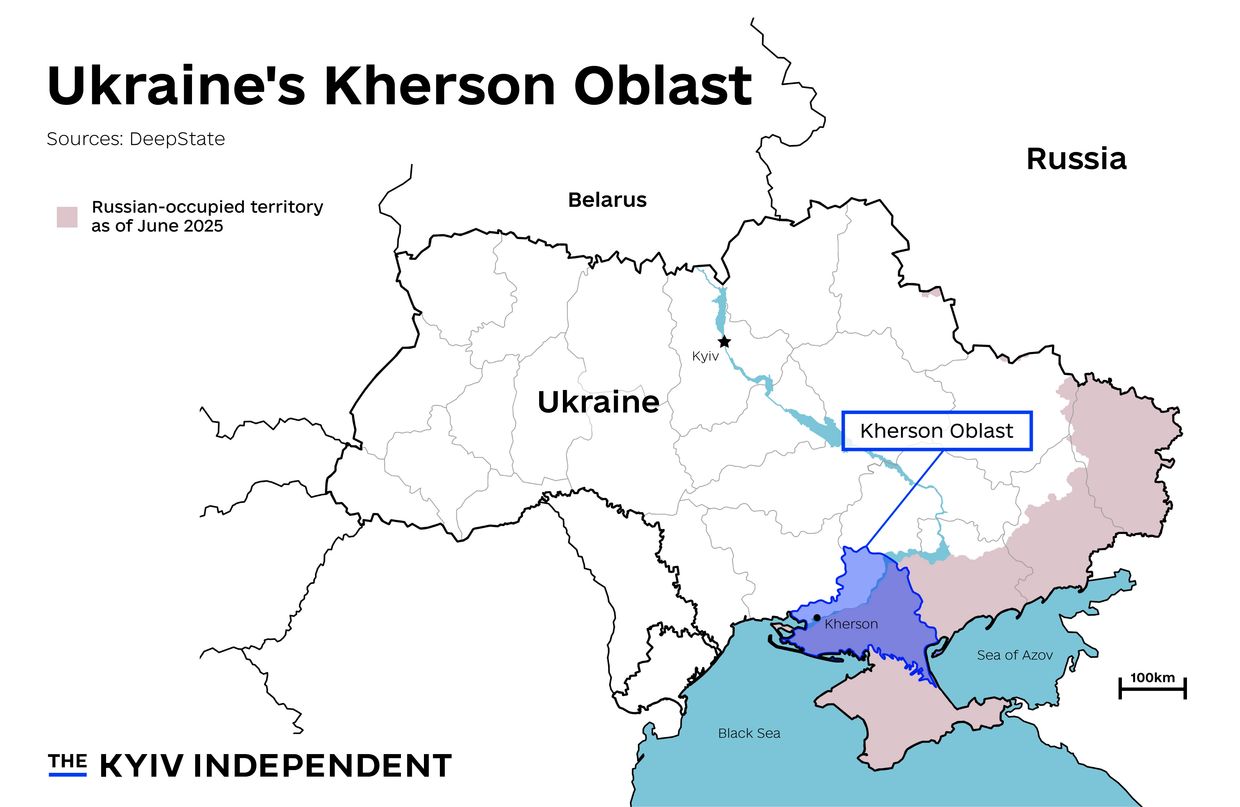
Casualties surged in late 2023 and early 2024, with numbers suddenly doubling in July 2024. April 2025 marked the deadliest month on record, with 42 civilians killed and 283 injured. Drone strikes continued into May and June.
On 23 June, a 65-year-old driver was killed in Kostiantynivka, Donetsk Oblast, when a drone struck a minibus. In Kharkiv region, a 58-year-old volunteer was killed on 22 May when a drone dropped a munition on a residential balcony. On 20 May, six civilians were injured when a drone hit a bus in Kherson Oblast.
The vast majority of casualties — 89% — occurred in territory controlled by the Ukrainian government. The UN says these attacks violate international humanitarian law, particularly the principles of distinction and precaution, and may in some cases constitute war crimes.
 The Kyiv IndependentNatalia Yermak
The Kyiv IndependentNatalia Yermak
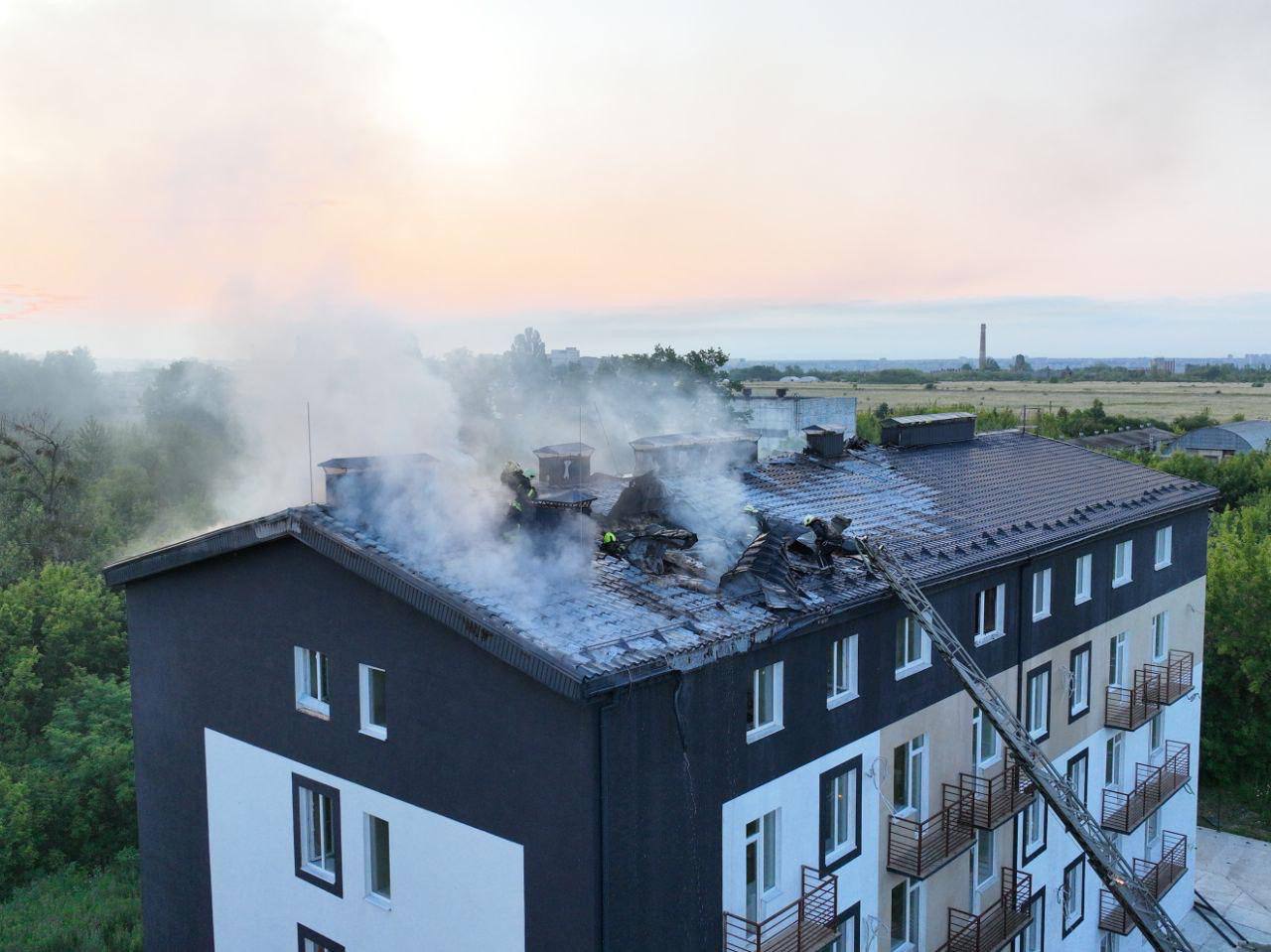

Russian attacks across Ukraine killed at least 23 people and injured more than 300 others over the past 24 hours, local officials said on June 25.
According to the Ukrainian Air Force, Russian forces launched 71 Shahed-type attack drones and decoys from multiple directions, including Bryansk, Millerovo, Kursk, and occupied Crimea. Ukraine's air defenses destroyed 52 of them.
In Dnipropetrovsk Oblast, a ballistic missile attack killed at least 20 people, 18 in Dnipro and two in the Samarskyi district, in one of the deadliest single attacks in recent weeks, governor Serhii Lysak said.
Nearly 300 people were injured, and extensive damage was reported to high-rise buildings, houses, dormitories, cars, schools, hospitals, administrative offices, and a passenger train. Drone strikes overnight also hit Nikopol and caused a fire in Synelnykove district.
In Kharkiv Oblast, nine people were injured in strikes on Kharkiv city, Kupiansk, and surrounding villages, according to Governor Oleh Syniehubov. Russian forces used a mix of weaponry, including air-launched rockets, glide bombs, and various drones. Civilian infrastructure was damaged, including residential buildings, houses, and an industrial hangar.
In Zaporizhzhia Oblast, five peope were injured in attacks across the Zaporizhzhia, Vasylivka, and Polohy districts, Governor Ivan Fedorov reported. Russian forces conducted four missile strikes on Zaporizhzhia and eight airstrikes on several towns. Around 300 drones, and over 150 artillery strikes were recorded across 13 settlements.
In Donetsk Oblast, three civilians were killed in Pokrovsk, Zoloti Prudy, and Novoiavlenka, Governor Vadym Filashkin said. 11 more were wounded in the region over the past day.
 The Kyiv IndependentOlena Goncharova
The Kyiv IndependentOlena Goncharova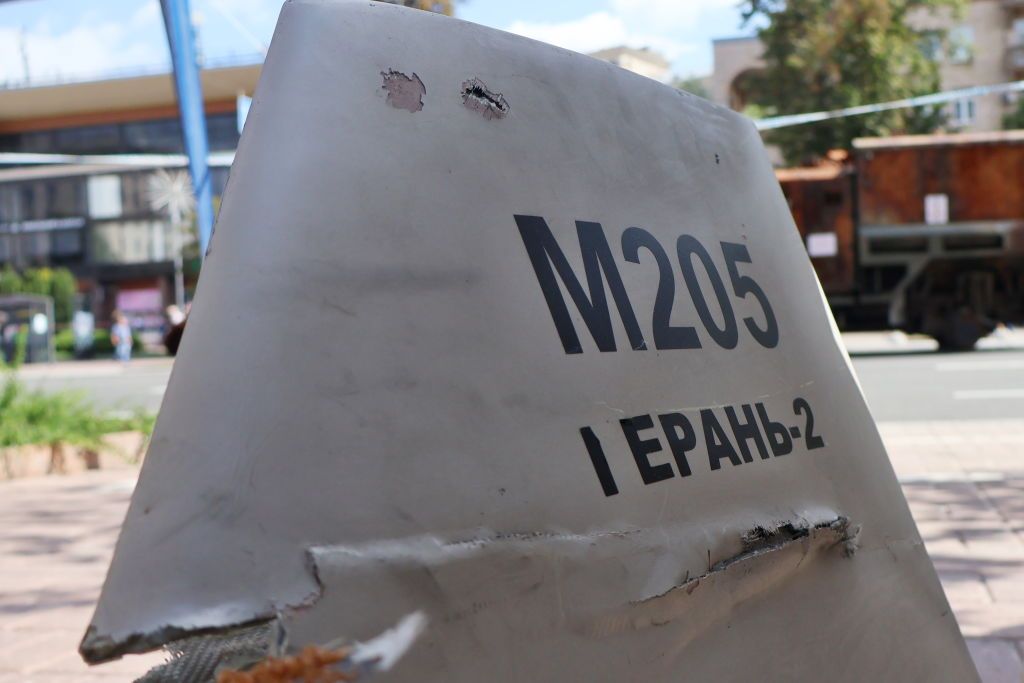
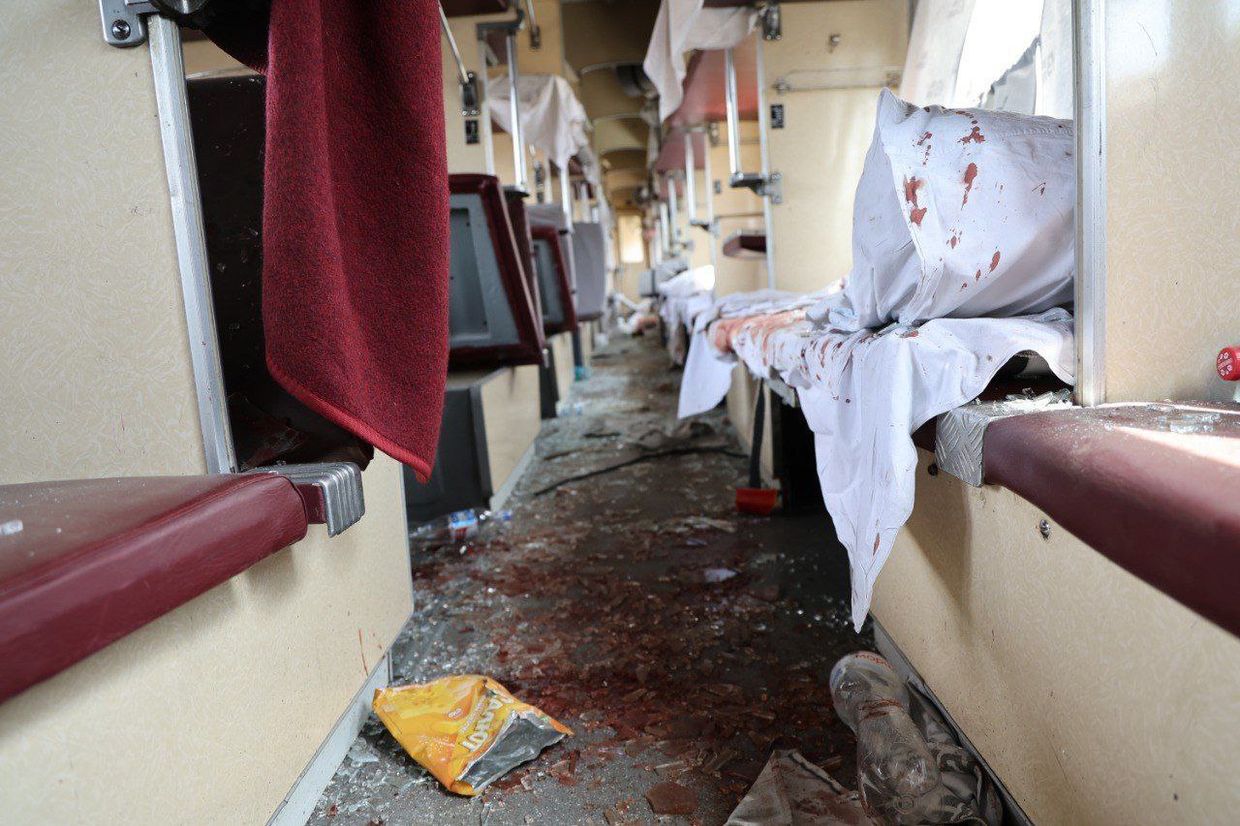

Editor's note: This is a developing story and is being updated.
Russia launched a deadly missile attack on the Ukrainian city of Dnipro on June 24, striking civilian infrastructure and a passenger train, killing at least 17 people and injuring scores of others, local officials reported.
Dnipropetrovsk Oblast Governor Serhii Lysak said the morning strike ignited a large fire and also damaged a dormitory, a gymnasium, and an administrative building in the city.
The Russian military also struck the nearby town of Samarske, Lysak said. Casualties were reported in both locations.
"Unfortunately, there are dead and wounded everywhere," he said.
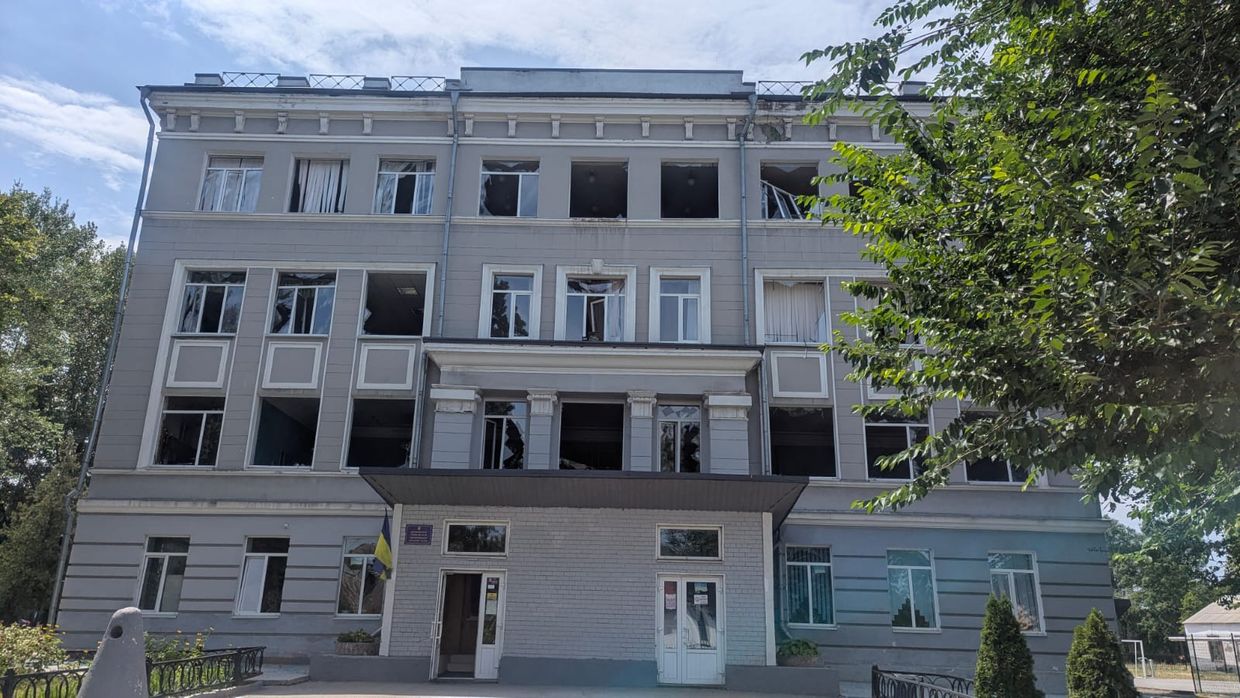
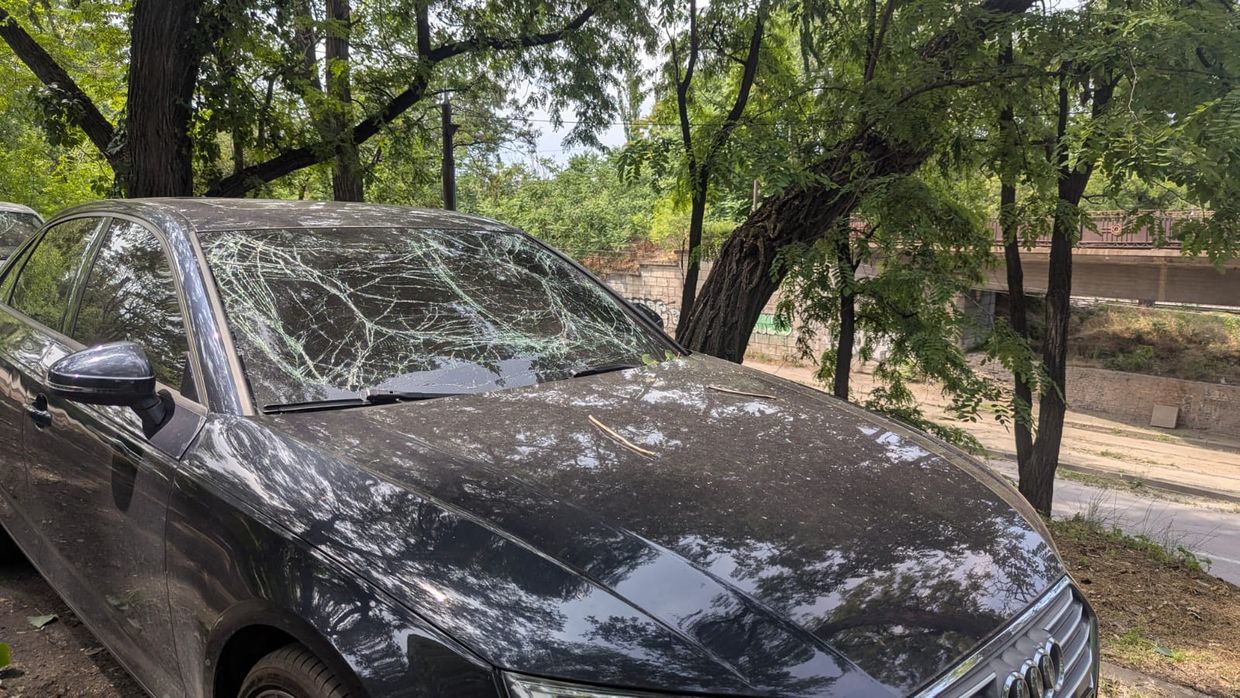
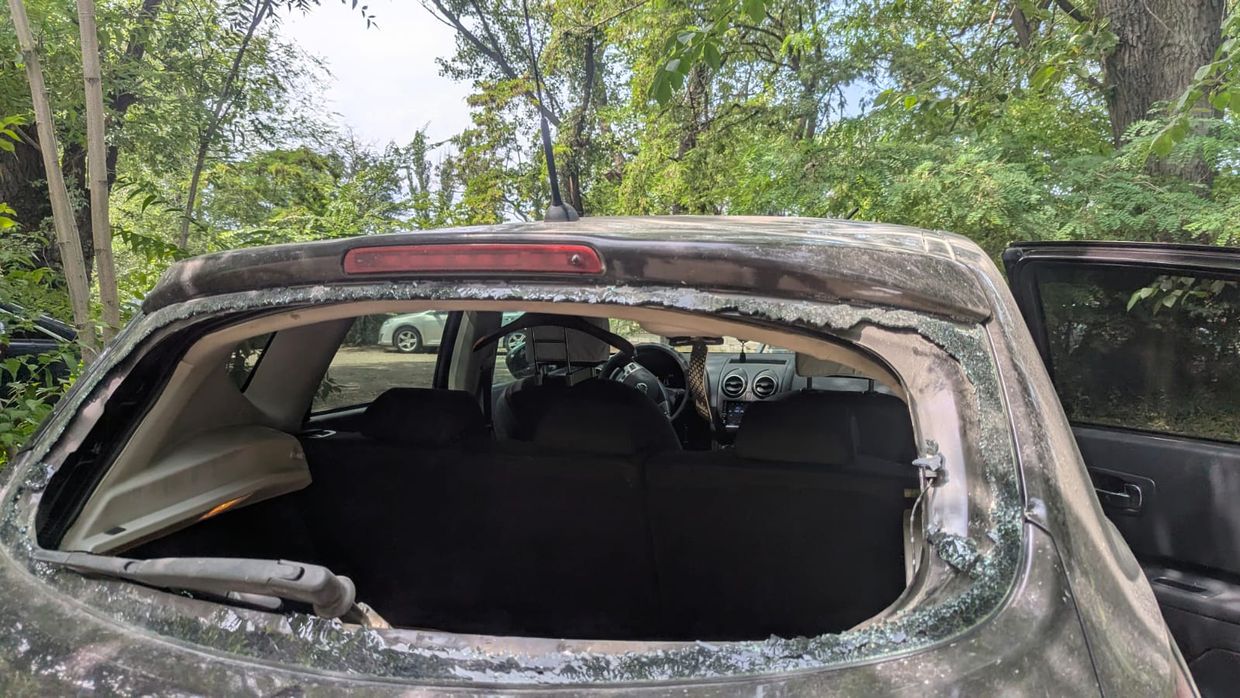
In Samarske, two people were killed, and 14 injured. Eight were hospitalized, with half of them in critical condition.
"As of now, more than 160 people are known to have been injured. Unfortunately, 11 people have died," President Volodymyr Zelensky said in a post on social media, adding: "The rubble is still being cleared, so the death toll may, unfortunately, increase."
Around 8:30 p.m. local time, the death toll rose to 17, while the number of wounded increased to 279, including 27 children, Lysak reported.
Almost a hundred of the victims remain in hospital, according to Lysak.
Ukraine's national railway company, Ukrzaliznytsia, said that a train traveling from Odesa to Zaporizhzhia was damaged in the attack.
"Ukrzaliznytsia is preparing a replacement train in Dnipro to evacuate passengers to Zaporizhzhia," the company said in a statement.
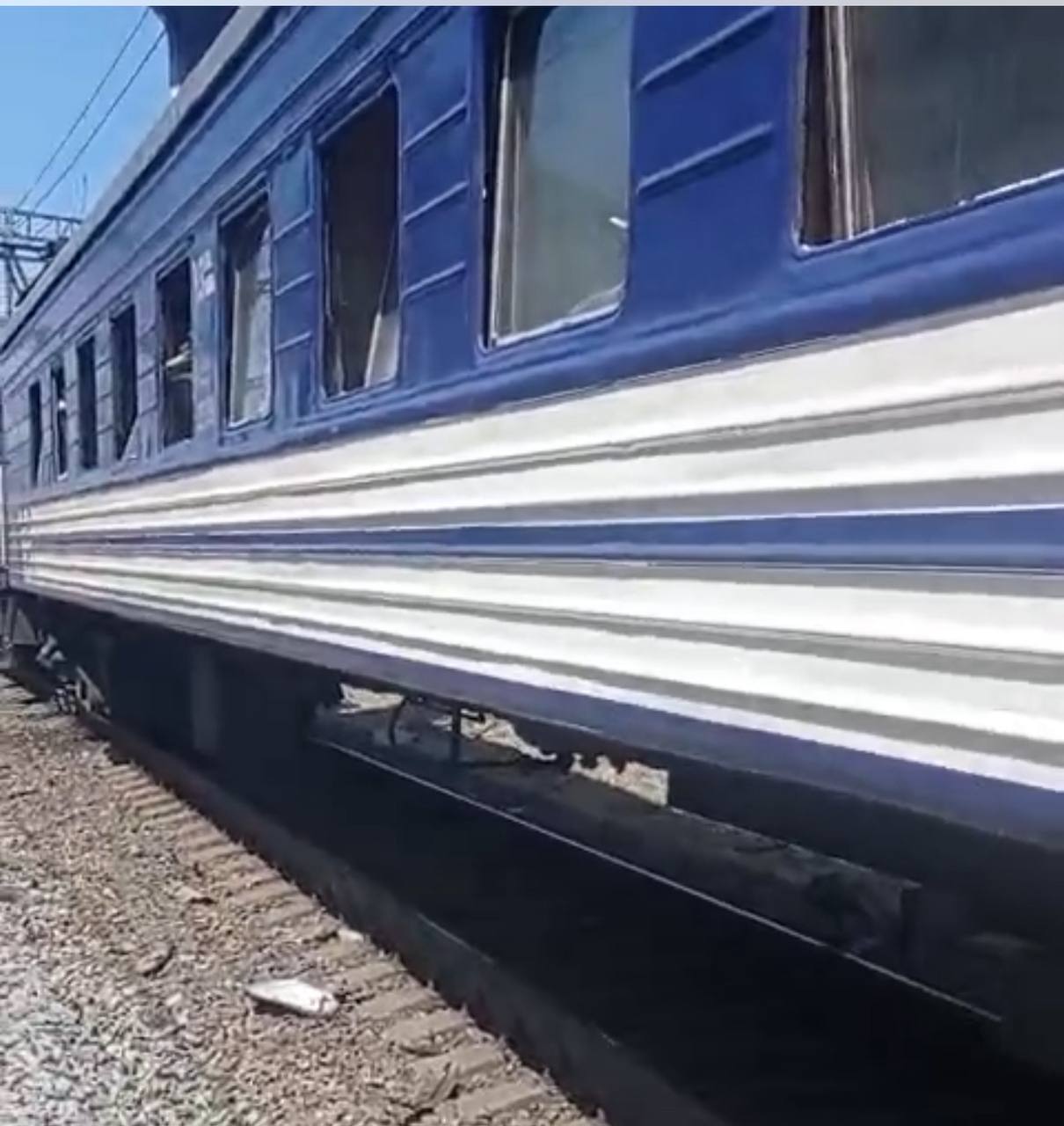
In an update, Ukrzaliznytsia said no passengers or railway workers were killed in the attack, though several people sustained injuries and are receiving medical care.
The attack came as NATO leaders convened for a high-level summit in The Hague. NATO Secretary General Mark Rutte warned on June 23 that Russia remains the alliance's most immediate and long-term threat.
 The Kyiv IndependentDaria Shulzhenko
The Kyiv IndependentDaria Shulzhenko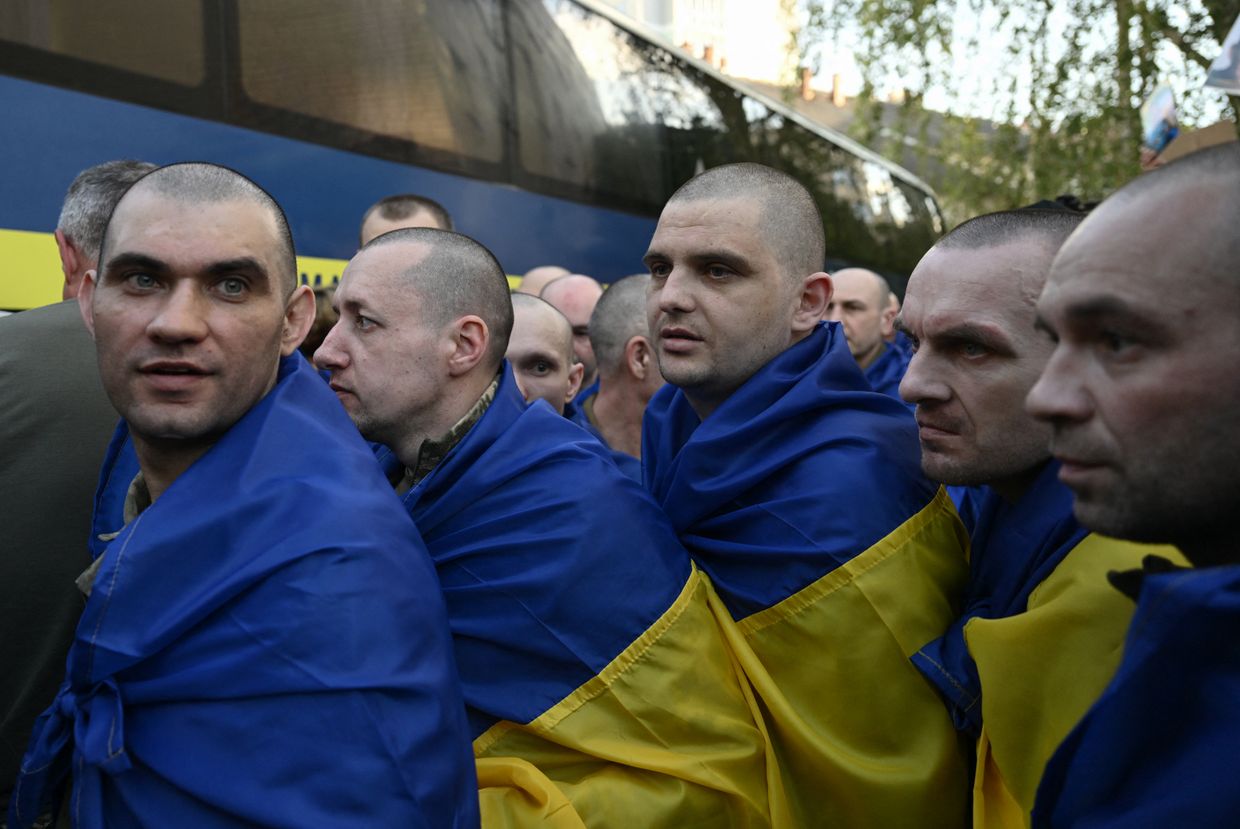
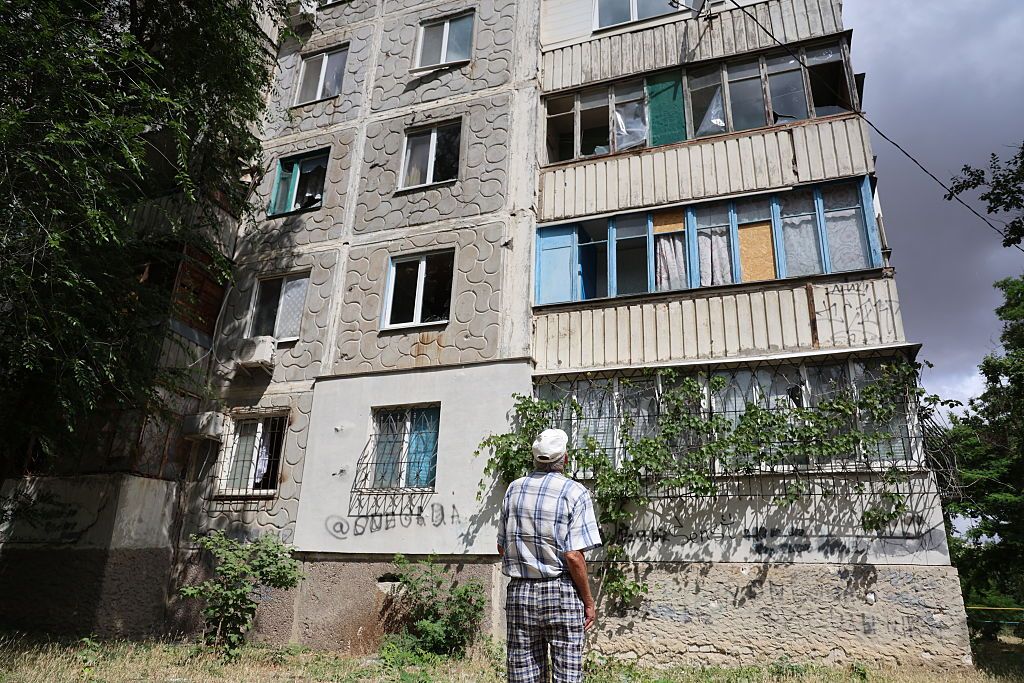

Russian attacks on Kherson Oblast killed four people and injured five others between June 23 and 24, local officials reported.
Russian forces launched drone and artillery strikes on dozens of settlements across the region, Governor Oleksandr Prokudin said on Telegram.
Twenty-nine settlements were affected, including the regional capital, Kherson, which shares the same name as the oblast.
The strikes damaged critical infrastructure and residential areas, including four private houses. A shop and several private vehicles were also reportedly damaged.
Kherson Oblast, located in southern Ukraine just north of Russian-occupied Crimea, has been repeatedly targeted by Russian forces since the start of the full-scale invasion.
 The Kyiv IndependentDaria Shulzhenko
The Kyiv IndependentDaria Shulzhenko